How to describe your product and service in a business plan like a pro
It’s deceiving.
You’d think that this part of a business plan does exactly what it says on the tin–describe your product & service offering– right ?
And yes, you are partially right.
But there’s a very specific way in which this description should be written to make sure that your business has the best chance of succeeding – in real life and under the eagle eye of a potential backer (if you’re preparing a business plan for external financing purposes).
Keep reading to find out the secret sauce to writing a winning product and service description:

WHAT is the Product and Service Description in a Business Plan?
This business plan section is also known as:
- Product and/or Service Overview
HOW Do You Write a Product and Service Description in a Business Plan?
So, what should a good product/service overview contain?
Here are some items to consider including into this section:
1. Portfolio:
The range of products and/or services that a business offers to potential and current customers.
2. Features and benefits (value proposition):
Explain what the product/service does and how it works.
3. Problem and solution (value proposition cont.):
The problem(s) the product or service solves. Every business needs to solve a problem that its customers face. Explain what the problem is and how the product or service solves it.
4. Innovation:
If the company is doing something new and different, explain why the world needs the innovation.
5. Proprietary advantages:
Any proprietary features that contribute to a competitive advantage. This could include: intellectual property (e.g., copyright, trademark, patent filings, trade secret), exclusive agreements with suppliers or vendors, exclusive licenses (e.g., for a product, service or technology), company’s own research and development activities.
6. Development stage:
Current stage of development of the product / service (e.g., idea, development, testing, prototype, already on the market).
7. Product life-cycle:
Estimate the life span of the product or service.
Specify whether the product or service under consideration is a short-lived fad or has a long-term potential.
8. Future:
Mention plans for changes and new additions to the current portfolio of products / services.
Describe any plans to move into new markets in the future (e.g., serving different types or sizes of customers, industries, geographic areas).
Make your best guess at when the business will be ready to address these markets and what it needs to do first to be ready.
9. Limitations:
If applicable, explain any risks or limitations associated with the product (e.g., liability issues like guarantees or returns), along with any legal advice received regarding these issues.
10. Visual aids:
Use photos, images, diagrams and other graphics to help the reader visualize and learn about the products / services.
If the business is tackling several distinct problems through different products / services, describe the solutions individually .
However, for a large line of products / services, there is no need to list each one, just identifying the general categories will suffice.
How LONG Is the Product and Service Chapter of a Business Plan?
This part of a business plan can be very short, just a couple of paragraphs, or it can spread over multiple pages, depending on how many products/services you offer and how much explanation they require.
If your products or services are particularly complex , technical , innovative , or proprietary , you will want to provide more information and spend considerable time describing them.
This is especially true if you are seeking funding for a new product or service, particularly one that is not immediately understandable to the business plan readers, and if potential funders are likely to be motivated by the specifics.
In any case, when describing a product or service, provide just enough information to paint a clear picture of what it is and does . A brief explanation of what you will be making, selling or doing is appropriate here.
Excessive detail makes this section cumbersome for a reader to wade through. Reserve detailed descriptions (e.g., production processes) for the Appendix.
In any case, it is a good idea to first summarize the value proposition of each product or service into a one short sentence, and only then continue with a more detailed description of the product or service.
If any images or graphics are available that would contribute to the understanding of the product or service, the writers of a business plan should use them.
Otherwise, include any product or service details , such as technical specifications, drawings, photos, patent documents and other support information, in the Appendix section of the business plan document.
TOP 4 TIPS for Writing a Product and Service Overview
Tip #1: features v. benefits.
Don’t just list the features of the product / service.
Instead, describe the specific benefits it will offer to customers – from their perspective.
Make it clear what your customers will gain through buying your product or service. Include information about the specific benefits of your product or service – from your customers’ perspective.
Features are not the same thing as benefits. And you need to understand both.
Confused? Let’s clarify:
What Is the Difference Between Features and Benefits?
Tip #2: problem v. solution.
If at all possible, present the information in the Problem >> Solution format.
Start by describing the key problem that your customers have, immediately followed by the solution with which you will address this need for your target market.
Tip #3: Competitive Advantage
You should also comment on your ability to meet consumers’ key problems or unmet needs in a way that brings your product or service advantages over the competition.
For example:
- If you have a common business, such as a restaurant:
Explain why your customers need your particular restaurant. Do you offer lower prices? More convenient hours? A better location? A different concept, such as a vegan ice-cream pop up store? A specialty that is not otherwise available in your area, such as a Peruvian ceviche or Hungarian goulash?
- If your company is doing something new and innovative :
What is it about the existing solutions that is subpar? Maybe you are improving on a mediocre product category, such as creating better medical uniforms for healthcare workers (e.g., more flattering cut, trendy designs, sustainable materials). Or perhaps your new blockchain solution has the potential to entirely eliminate the middle-men in an entire industry.
Although the subject of competitive advantage regarding the business as a whole will be fully explored in the Market and Competitor Analysis part of a business plan, it is advisable to touch on it here also – in the context of the company’s products and service.
Tip #4: Validating the Problem and Solution
Speaking of which, when you are doing market research and analysis for your business plan, remember to validate the problem and solution your product or service is addressing.
There is a plethora of minor issues out there that people are perfectly fine with just tolerating. To build a solid business, though, you need a problem that a sufficient number of people are motivated to solve. That is, that they recognize it as a problem that’s worth paying you to solve. Even if they didn’t realize it was solvable until they were presented with your solution.
So, how do you get evidence that prospects are willing to pay for your solution?
Validation of Problem
Describe what you’ve done so far to confirm that the problem you are focused on is a real problem for your customers.
- Existing Business:
For an established business, this is probably just a matter of recapping your success in the marketplace. Your customers have already voted with their wallets.
- New Business:
For a startup, it is important to survey and have conversations with as many potential customers as possible about where they are having problems, how they solve them today, and validate that they are interested enough in addressing those problems to pay for a good solution.
Validation of Solution
Describe how you have tested your ideas with existing or potential customers to confirm that there is a good market for the products or services you plan to offer. Summarize the positive customer feedback or market traction that you have achieved with your solution so far.
For an established business, the answers probably lie in your paying customer base – their existence itself, combined with their repeat business, word-of-mouth referrals, follow-up customer surveys, and other indicators of customer satisfaction.
For a new business, you can start validating your solution immediately by trying it out with potential customers, even informally or at no charge, to get their opinion. If your product or service does not exist yet, talk to prospects about what you plan to offer and measure their feedback.
In summary, this section should answer the million dollar question:
What makes you think that people will buy, be satisfied with, and recommend your products or services?
Related Questions
What are products and services.
Products and services are items that businesses offer for sale to a market. While services are intangible, meaning that they do not exist in a physical form, products are of tangible nature, in other words – you can touch them.
What is a Product Line?
Product line is a group of related products that are all produced or sold by one entity and typically marketed under one brand name.
What is a Service Line?
Service line is a group of related services that are all produced or sold by one entity and typically marketed under one brand name.
Sign up for our Newsletter
Get more articles just like this straight into your mailbox.
Related Posts
Recent Posts
ZenBusinessPlans
Home » Business Plans
How to Describe your Product in a Business Plan
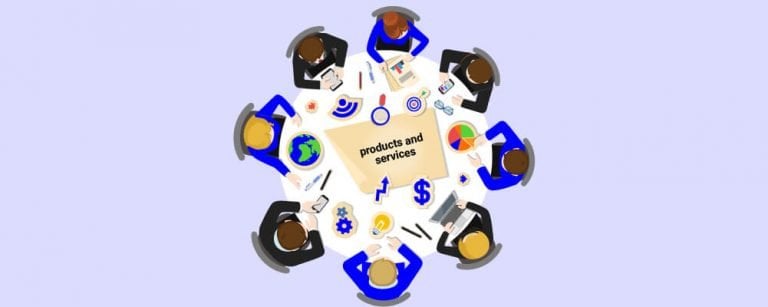
The product or products your business intends to produce or offer will have to be described in the product description section of your business plan. This section of your business plan is meant to explain how your product will stand out from comparable items in the market.
You have to clearly explain its concept, coupled with all aspects of purchasing, manufacturing, packaging, and distribution. You should also identify your suppliers, costs, and how the product you are offering fits into the current market.
Note that the product description in your business plan is more than a simple listing of product features. In this section, you will need to highlight your product’s most unique characteristics that will ensure it stands out in the marketplace and attract buyers who won’t mind paying your price.
Note that a properly written product description in your business plan can entice investors and help your business grow. Make sure you describe what you are offering in layman’s terms, to guarantee that someone who isn’t conversant with your business will grasp and be excited about it.
It may also be necessary to provide some basic background if this is an area or industry that people are not so familiar with. While you write up the Products and Services description section of your business plan, always keep your reader in mind.
What to Include in the Products and Services Description Section of Your Business Plan
Just as was noted above, the products and services section of your business plan will have to explain in detail your product or service, its demand in your market, and how it intends to compete with other businesses selling the same or similar products or services. Nonetheless, the product and services description section of your business plan is expected to include:
The Product or Service Description
It is important the product description section of your business plan clearly explains the concept of your product, coupled with all aspects of purchasing, manufacturing, packaging, and distribution. What are your product and service, and how does it work? How will this product benefit your customers? How do you plan to make it or how do you intend to get it made?
Product Comparison
This section of your business plan will also have to explain how your product compares with similar products in the market. What makes this product or service unique or better than what’s already obtainable in the market? Why would anyone prefer your product or do business with you?
You will need to describe how and why you are competitive. How do you stand out, and why do your business and everything it offers have such a viable chance at succeeding? In talking about your product or service, always try to answer why a client would want it and how it can make their lives better or more profitable?
Accreditations/Intellectual Property
For businesses that have had their product tested by industry experts, you must include this information when describing your product. Don’t forget to highlight any certifications, trademarks, copyrights, or patents.
Have it in mind that these added advantages or achievements can give you and your product an upper hand. Verified patents and trademarks can also heighten the value of your product especially since it shows that only your company can manufacture the product for the life of the patent.
Have it in mind that a product’s life cycle includes the idea, prototype, and expansion stages. If you are still in the idea stage, you must buttress in your description how you intend to get the product made and why your product matters.
If you maybe already have a prototype, outline your plans for evaluating the prototype and manufacturing your product. If your business has been making the product but is looking to expand to keep up with demand, ensure you explain this when describing your product in your business plan.
You will also want to include the cost of your product and how that cost aligns with other comparable products on the market. In very concise detail, explain how you came to this price, including the cost to manufacture, selling price, and profit margin.
Sales and Distribution Strategy
Also, take your time to explain how and where you will sell your product. Have in mind that your options may include online stores, brick-and-mortar locations, and vendors. If you already have vendors selling your product, ensure to note who they are and their locations in this section of your business plan.
Fulfillment
When describing your product in your business plan, it is also important you describe your plan to ensure your product gets to the intended customers. This should include manufacturing details and delivery specifics. If you plan to outsource the production of your goods, don’t forget to note manufacturer specifics such as location and production time. Also, remember to include the approximate delivery times and methods.
Requirements
Will you require any special equipment or technology to provide your product or service? Also explain if any specialized technology, materials, or equipment will be required to manufacture your product.
You will also have to explain your plans for product development and introduction especially as your business grows.
Photos or Brochures
Also, make sure that your potential investors can get a good insight into your product through photos and brochures. Don’t forget that your business plan is expected to have an appendix for photos and brochures. Also, don’t forget to refer to them in the product description section.
Tips for Writing a Product Description
To ensure you describe your product thoroughly, here are some vital tips to guide you;
- Always remember the reader. The product description section of your business plan must note your product’s most vital information. Always remember to make this section very easy to read and understand. Consider making it better by leveraging numbered lists and bullets.
- Focus on benefits. When describing your product, you must explain how its features can provide value to consumers. Translate your features into benefits, and remember that the aim is to describe how your product or service will be a solution to a problem or improve a client or customer’s life.
- Highlight the features of your product or service. To attain substantial success in any business, your business will need the ability to set itself apart from other businesses that offer or sell the same products and services. Take your time to analyze key features, such as price point or level of service, or anything that makes your product unique in the market.
- Show off a little. Don’t forget that you are selling a product and also selling yourself as the most viable provider of that product. Ensure to include all vital educational or industry-specific experiences and awards in this section. If you have endorsements or testimonials specific to your product, include them as well.
- Show the need for your product. Also make sure you explain how your product will cater to a need or improve life, showing why your product is very necessary to the consumer. This is very pertinent if your product has no current market.
The product and services description section of your business plan is meant to provide the reader with an explicit understanding of why you are in business, what you sell, how you will compete with what’s already available, or how you intend to fill a niche that no one else is currently meeting. Noted above are things you need to consider when creating the product description section of your business plan to ensure that it will indeed grab your readers’ attention.
More on Business Plans
Retail | How To
How to Write a Product Description [+ Template & Examples]
Published September 1, 2023
Published Sep 1, 2023
REVIEWED BY: Agatha Aviso
WRITTEN BY: Brigitte Korte
This article is part of a larger series on Retail Management .
- Step 1: Set Objectives
- Step 2: Identify Target Audience
- Step 3: Establish Tone
- Step 4: Craft Must-buy Item Features
- Step 5: Focus on Format & Length
Step 6: Write Your First Draft
- Step 7: Revise & Optimize
- Do’s & Don’ts
Bottom Line
Product descriptions are key to building customer trust and successfully selling your products. To be effective, product descriptions need to go beyond simply describing the product. They should also inform your customers, convey your brand, and get your store visited by searchers—bringing in sales and boosting other key performance indicators (KPIs).
Continue reading for our seven-step guide on how to write a product description that sells, along with effective examples from online stores. You can also use our free product description template below to get started now.
FILE TO DOWNLOAD OR INTEGRATE
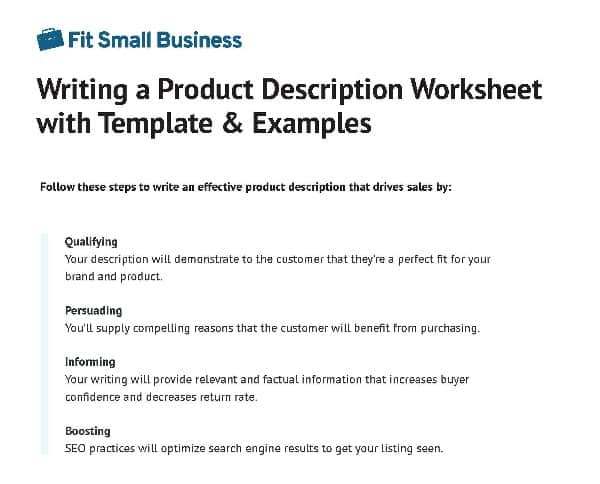
Thank you for downloading!
Step 1: set objectives for your product description.
Before getting started, it is important to understand the elements of a good product description so you can have a clear vision of what you are trying to accomplish. By knowing where to focus your attention and how to measure your listings’ success, you have the foundation for a profitable product description.
An effective product description will:
- Qualify: Demonstrate to the customer that they’re a perfect fit for your brand and product
- Persuade: Supply compelling reasons that the customer will benefit from making the purchase
- Inform: Provide relevant and factual information that increases buyer confidence and decreases return rate
- Boost: Optimize search engine results to get your listing seen
Though the bullets above outline the main goals your product descriptions should address, you might look at a few other key retail metrics to identify if there are any additional objectives you want to address. Consider the following:
Return Rate
Return rate can be significantly impacted by honing in on your listings’ specificity and accuracy. Delivered items not matching their product representations is among the top reasons for returns . According to a 2020 survey from SalesCycle, 64.2% of shoppers have returned purchases due to listing discrepancies . So, the more informed your customers are, the less likely they are to return their orders.
Bounce Rate
Bounce rate, or the percentage of page visitors that leave without taking desired actions, can be mitigated by crafting functional descriptions as well. Whether customers are comparison shopping or checking out an ad, they ultimately navigate away from a page if they feel they’re in the wrong place. By using tone and content thoughtfully tailored to your target demographic, your writing can retain on-page interest by qualifying and demonstrating the customer’s compatibility.
Shopping Cart Abandonment
Shopping cart abandonment is usually caused by friction in the checkout process, so product listings are your first line of defense against it. By clearly disclosing influential details in the product description—like price, shipping cost, delivery date, and handling time—shoppers are less likely to abandon their orders when met with this info later on.
If any of these factors are less than ideal, the product description is the perfect place to justify them in alluring ways. For example, a package arriving three weeks after the purchase date is much easier to swallow knowing that the goods are handmade to order by a skilled artisan. Similarly, buyers are less likely to seek the same product for a cheaper price elsewhere if proprietary materials and superior construction give it an edge.
Store Traffic
Maybe you’re not getting enough visitors to your store in the first place. Poorly written or nonexistent product descriptions have a huge impact on search engine rankings, so structuring your listings with SEO in mind is a surefire way to drive traffic.
Step 2: Identify Your Target Audience
The next step is defining your buyer; this will help you understand who to write product descriptions for and to whom they should appeal.
Whenever I define a target market, I start by choosing key characteristics like gender, age, socio-economic position, and location. Once I have a picture of who my target audience is and I can describe them, I research their behaviors and preferences, like where they like to shop, how much they spend, how often they shop, what makes them want to buy, and more.
Learn how to identify your target customer and create a practical customer profile with our guide—complete with resources, examples, and free templates.
If you have a clear picture of your target audience and understand what makes them tick, you will be able to turn product-centric copy into vibrant, customer-centered conversations that appeal to your market’s sensibilities and help convert browsers to buyers.
For example, at my store, our target market was young women ages 15 to 40 with medium levels of expendable income living in Denver and the surrounding suburbs. In general, via personal experience and outside research, I found that this group preferred high-quality fabrics, liked receiving styling help, and preferred modern, trend-forward pieces.
To appeal to our target audience in product descriptions, we included information about fabric and care, as well as sourcing and fabric features. We also mentioned what trends the pieces spoke to or could complement, and we left pairing suggestions to help turn single pieces into complete looks.
Here is another example of two versions of a product description—the first written with zero focus on the customer profile and the second written with the customer profile in mind:
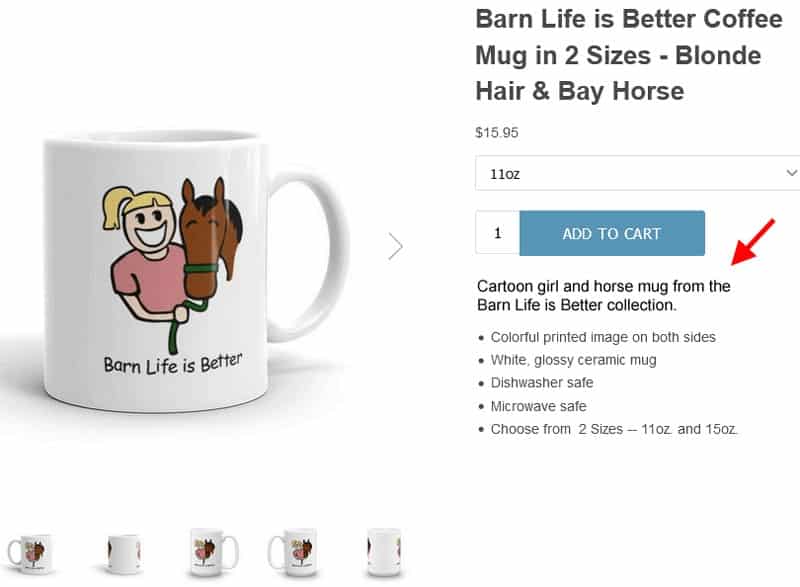
The information is detailed and accurate, but there’s no chance to make a connection with the reader and qualify their fit for the product. (Source: The Horse Junkie)
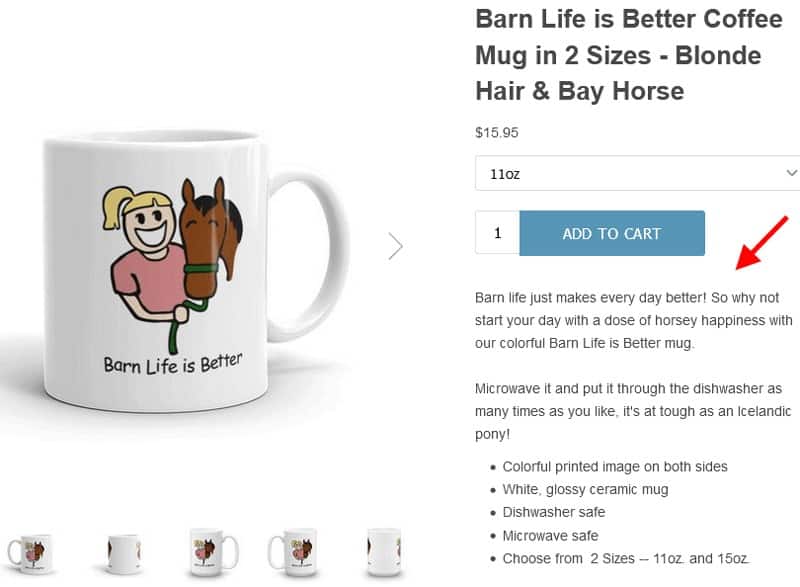
By rewriting the product description with the target audience (horse lovers) in mind, the listing relates to the customer and draws them in. (Source: The Horse Junkie)
Step 3: Establish Your Listing’s Tone
The tone of a product description is the “personality” of your store or brand as conveyed through your writing. Having a consistent and clear tone is a large part of successful branding, and incorporating brand tone into your product descriptions can have a big impact.
Learn more about building your brand with our guide to brand presence and how to build it .
To begin, you have to have a clear picture of your brand. Is it professional? Formal? Girly and fun? Technical? In the case of my store, my brand was feminine and youthful with an outdoorsy, Western bent. I found that the best way to hone in on a tone that fit my brand’s image in my product descriptions was to imagine my store as a person, and then describe the product as that person would.
You can see in the example below that I used a more conversational voice and playful language, as well as helpful styling details to set a tone that matches my brand image, “feminine and youthful with an outdoorsy, Western bent.”

The tone of a product description should reflect your brand image.
Step 4: Turn Item Features Into Must-buy Benefits
When I started, I focused solely on hard features, specs, and key details in my product descriptions. While all this information is highly important, I was missing a key aspect of an effective product listing: conveying how and why my product will make my buyer’s life better. Sure, you want to make your product’s high points shine, but your real focus should be creating the perfect excuse for the buyer to snap it up.
To do this, you’ll need to convert facts about your product (like construction details, intended use, special features, material, and specs) into user benefits. Here’s a powerful example:
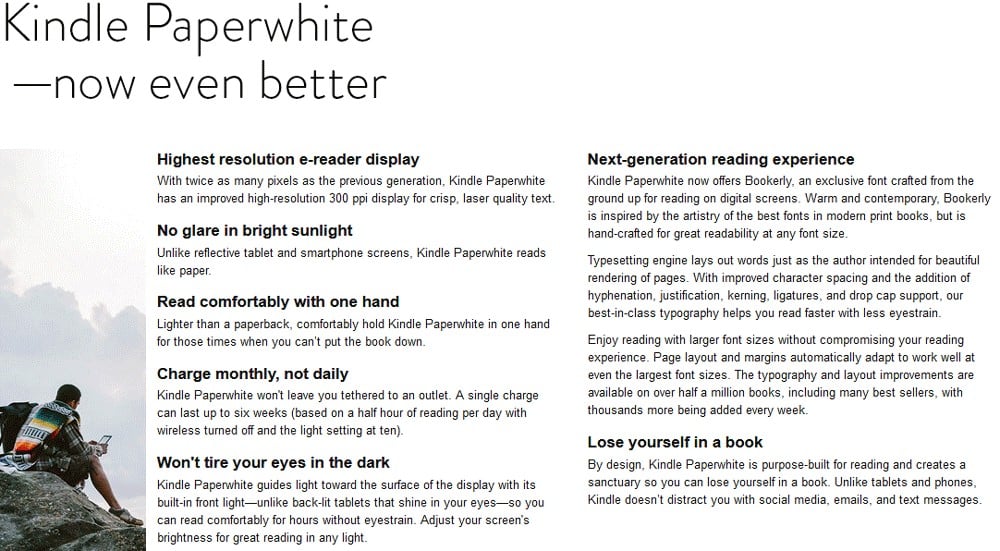
(Source: Amazon)
By considering the target audience and using a decisive tone, the description of this Kindle translates hard facts into purpose-driven, relatable benefits.
The writer could have mentioned that the device has a high-capacity 1600 mAh lithium-polymer battery, but converting that raw feature into the benefit it provides allows shoppers to envision the experience of minimal charge time. Similarly, the product is described as being “lighter than a paperback” to “read comfortably with one hand,” which is far more compelling than simply stating that the device weighs 6.4 oz.
A successful product description will turn impersonal details into personal advantages. To do this effectively, you’ll need to focus your attention on what your target buyer values.
Step 5: Focus on Format & Length
According to Chartbeat’s analysis of page views and engagement , you only have 15 seconds to win your customer’s interest before they’re closing out of your store’s tab and moving on. That’s a small window of opportunity, so it’s crucial to make your listings as eye-catching and scannable as possible.
Product descriptions are not the place to write a mountain of prose—it’s practically guaranteed that your viewers won’t read it. Instead, create a quick-scan layout that puts your product’s benefits front-and-center, like this:
Sticking to a template maximizes efficiency and consistency. In fact, it’s how I was able to crank out product descriptions in volume.
Expert Tip: I like to close out my product descriptions with a statement that invites customers to buy the item like, “One click makes it yours,” or even “Limited availability” for seasonal items.
With the groundwork laid out, you are ready to start writing your product descriptions.
Keep these considerations in mind as you dive in:
- What are the goals you have set for your listing(s)?
- Who is the target buyer you’re trying to reach?
- What kind of tone would an in-person conversation with them have?
- Which features of the product should be highlighted, and how do they translate into consumer benefits ?
- How will the format of your product description take shape?
When I wrote product descriptions, I also liked to incorporate proven copywriting techniques into my work. While readers respond negatively to product descriptions that come across as over-engineered or packed with marketing-speak catchphrases, skillfully adopting a few copywriting techniques can improve your descriptions’ impact.
Create a Sense of Urgency
To persuade customers to buy now rather than later (which often turns into never), you need to reasonably convey that it’s in their best interest to do so.
Mention stock scarcity to compel viewers to act quickly with additions like, “Only three left in stock!” or “Only 2 size SM available!”

This online store compels visitors to buy with limited stock notices. (Source: TheGood)
Limited-time offers are also highly effective sales drivers. Explaining the time-sensitive nature of the purchase with copy such as, “Sale ends tomorrow, don’t miss out!” is a great way to boost conversions.
Building time-dependent deals into your checkout process is another way to impart a sense of urgency. By letting the customer know to “Order in the next five minutes to score free shipping!” on the product page, you’re increasing the likelihood of a sale.
Ask “Yes” Questions
A tried-and-true principle used in sales and copywriting alike is that answering “yes” to a question makes a customer more likely to answer “yes” to following questions—including the question of whether or not to buy.
Think about how your product’s benefits relate to your target buyer, and you’re sure to find some queries with obvious “yes” answers. For example, “Does your cat’s litter box make the room smell not-so-fresh?” or “Are you dreaming of a seaside getaway?”
Appeal to the Senses
An effective product description should encourage your reader to connect with the item you’re offering. A powerful way to accomplish this is to infuse your writing with sensory words.
Reading a listing that vividly describes how the product feels, tastes, smells, and looks actually activates sensory parts of the brain , making a real and lasting impact on the customer. Think of words like these that apply to your item:
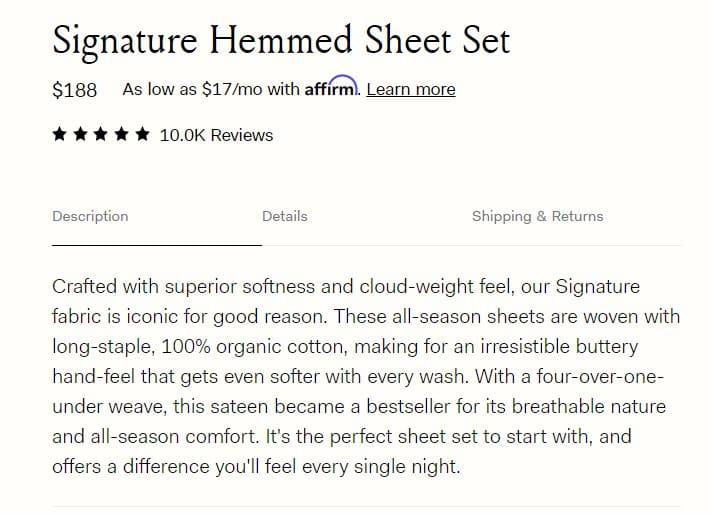
This product description uses terms like “cloud-weight” and “buttery hand-feel” to appeal to the reader’s sense of touch. (Source: Boll & Branch)
Above all, your copy to be customer-focused rather than brand-focused. Counterintuitively, what matters and speaks to the customer is almost certainly different from what matters to the retailer. So always consider how your writing will be perceived by your audience and do the most to make it personal.
Once you have a first draft written, read it aloud to yourself. Does it sound conversational and appropriate? Does it flow nicely and naturally, without any clunky sentences or unnecessarily big words?
If you can confidently answer “yes” to those questions, it’s time to bring your product description into the final stage.
Step 7: Revise & Optimize
The next step is to edit your work. First, go back over each word carefully to check for spelling and grammar errors. You can either paste your work into a Google or Word document and use their editing tools or you might consider a grammar-check plug-in, like Grammarly, for a more advanced option.
Once through the initial editing stage, you will want to optimize your description for Google, also known as search engine optimization (SEO).
SEO: The on-page practices that allow websites to appear in relevant searches thus improving the site’s traffic quality and quantity.
When I first learned about SEO practices, optimizing for the search engine was my biggest focus when writing. I soon learned, however, that modern search engine algorithms are highly sophisticated and can tell when you are prioritizing SEO considerations over customers.
As a general rule, stay customer-focused and use the elements we have already discussed. Including information that is most relevant to your customers is what will get you ranked, and antiquated SEO practices, like keyword-stuffing and shooting for hyper-specific word counts, can actually work against you in the modern age of ecommerce.
Reviews and user-generated content are super important to modern consumers and including them on your product pages will contribute to your listing’s visibility.
In addition to staying customer-focused in your descriptions, you should also be sure that you are targeting the right keyword. Your keyword is the term that customers use to search for your product in a search engine. Your keyword is typically just the name of the product, but for items that can have multiple names, you will need to target the one that is most relevant based on search volume and the other search page results.
For example, if I am selling custom playing cards, I will need to determine how people who are looking for this product search for it. Are they searching “custom playing cards” or are they using different language like “customizable deck of cards” instead? This comes down to the volume of searches associated with each search term as well as the search page results for both of those terms. The phrasing with the higher search volume and similar results is going to be your best bet for a keyword.
Once you know your keyword, you should include it in your title and/or description, so that Google can recognize the product and display it on relevant searches.
For more information on finding the best keywords to boost your store’s traffic, check out our Ultimate Beginner’s Guide to Ecommerce SEO .
Overall, search engines reward clarity and user-friendliness. The top-ranking products on Google will almost certainly have descriptions that clearly inform the reader and stay firmly on brand. Use them as guidance and inspiration, but keep in mind that uniqueness is a hefty contributor to SEO as well—so make sure your copy is 100% original.
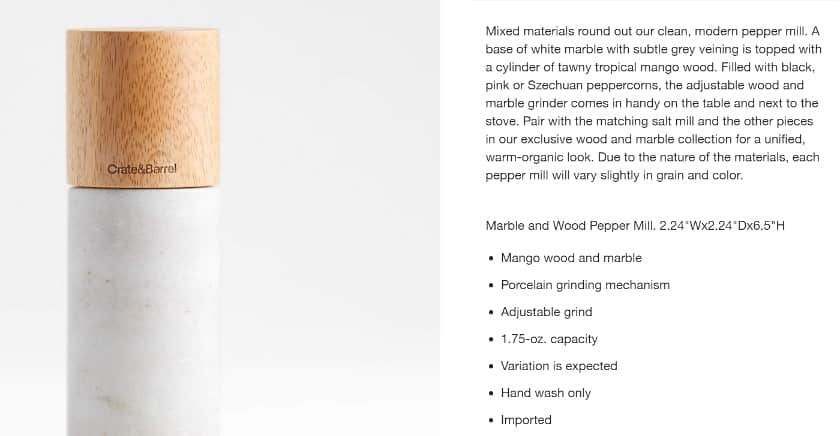
This product description targets the primary keyword “pepper mill” as well as some additional, more refined keywords—like “wood pepper mill” and “marble grinder.” It also provides clear and concise information that appeals to readers and Google’s search rankings. (Source: Crate & Barrel)
Do’s & Don’ts of Writing Product Descriptions
A good product description can make or break a sale. Here are some final tips for crafting yours:
- Be personal. Use the word “you” to speak directly to your buyer. Ask questions, incorporate product-centric stories, and make it feel conversational.
- Use justified superlatives like “top-rated on Trustpilot” or “brightest flashlight in the world with a 100,000-lumen output.” Did your product win an award, receive notable mention, surpass a standard through testing, or earn an impressive number of 5-star reviews? Those are substantial recognitions that carry meaning for your customers.
- Check for readability. Go beyond your writing’s format to make sure your product description looks good and legible on the page. Font color, typeface, background, and placement should all work together to be on brand and, most importantly, readable.
- Use unjustified superlatives like “best in class” or “top-ranking brand.” If there isn’t any real class or ranking that you’re referring to, nix it.
- Use hollow verbiage like “excellent quality” or “cutting-edge.” Opt for descriptive specifics instead of meaningless filler.
- Use excessive jargon. Your tone will dictate whether or not it’s appropriate to sell your target buyer using specialized, highly technical language—but in most cases, it is confusing and off-putting.
- Use copied content. As mentioned above, duplicate text from elsewhere on the web hurts your search engine rankings; it’s not a good look for your brand in general.
Product Description Frequently Asked Questions (FAQs)
Click through the questions below to get answers to some of your most frequently asked product description questions.
What is a product description?
A product description is the part of an online listing that explains what an item is and why it’s worth buying. A well-written product description can transform your online store by qualifying, persuading, and informing the reader, as well as boosting your listings’ visibility.
How do you write a product description for a service?
When writing descriptions for products, first, consider who your target customers are, your brand image (tone), and the objectives of your description. Then you will want to highlight the features of the service and format the information in a scannable way. Finally, optimize for SEO.
What should you include in a product description?
You should include a description of the product, a list of features and their benefits, and a call to action.
How long should a product description be?
Different products require different amounts of information, but your product description should always include all the information that a customer needs to make a confident purchase, and no additional, extraneous text.
How do you write a product description for clothing?
First, describe the garment, then list its fabric and care information, then include a sizing chart, model information, and additional features/benefits.
There’s a lot that goes into writing product descriptions. With the guide above, however, anyone can do it—and the results are worth it. Spending a little time honing in on your customer profile, tone, format, and SEO will lead to increased conversions, along with boosts to other important KPIs.
About the Author

Find Brigitte On LinkedIn
Brigitte Korte
Brigitte is a retail specialist and staff writer with brick-and-mortar management experience. Before joining FSB, she managed a storefront for several years, working in everything from merchandising, to buying, to sales analysis. Brigitte also has a background in writing, research, and publishing, with an undergraduate degree in writing.
Join Fit Small Business
Sign up to receive more well-researched small business articles and topics in your inbox, personalized for you. Select the newsletters you’re interested in below.
How to write a product description that sells (+ 11 examples)

A product description is copy that tells customers about the features of an offering. Its purpose is to help buyers understand why they should purchase the product. Effective descriptions generate sales by explaining the product’s unique value proposition as well as how it solves a frustrating problem.
Why are product descriptions important?
The buyer’s decision-making process initiates long before he or she arrives at your product pages. Whether you’re selling consumer products or business services, your target customer has likely encountered a problem and is looking for a solution.
A weak product description can be the Achilles heel of a marketing campaign.
Marketing assets like traditional advertisements, social media campaigns, blogs and videos generate awareness of your brand and drive readers to your ecommerce website or store. At that point, your product descriptions take over and perform the heavy lifting. It’s the product description’s job to get the buyer over the last hurdle.
A weak product description can be the Achilles heel of a marketing campaign. All of the other assets can work perfectly, but an uninformative product description can derail everything at the last minute. In fact, 98% of shoppers have stopped mid-way through a purchase because content on the page was incomplete or inaccurate.
Your marketing campaigns should increase interest in your offerings, while your product descriptions reinforce trust in your brand. Missing information, spelling errors, bad product photography and similar blunders can quickly erode trust in your brand. On the other hand, polished product descriptions make your company look legitimate and professional. You need that trust to make sales.
How service descriptions support B2B marketing
Marketers who are in the business of selling intangible services face a unique challenge. How do you describe something that has no physical form? What type of imagery do you use to showcase a service with little to no observable features?
Service descriptions can be more challenging to write, but they follow a pattern similar to descriptions of products. Namely, their purpose is to help buyers make a final decision.
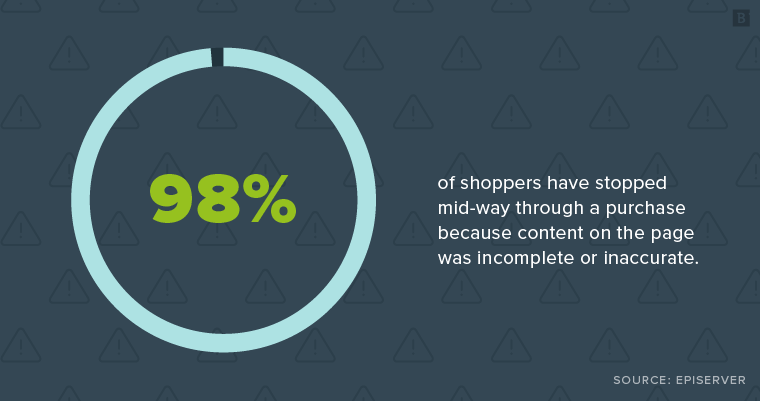
If your organization has a sales team, there’s a good chance you already have everything you need to craft effective service descriptions. It’s best practice to align your descriptions with your sales pitch. This creates consistency for your buyers and ensures your sales team isn’t thrown off guard by an unfamiliar claim.
Service descriptions help to convert customers by showing them the solution to a challenge. For example, if buyers are looking for accounting services, they may want to know things like what types of reports the firm can produce, how frequently they will be available for consulting, etc.
Many of the best practices described below will apply to service descriptions. Always keep in mind the customer’s goals when describing the products or services you provide.
11 product description best practices that increase sales engagement
Effective product descriptions not only give customers information about the offering but also deliver psychological appeals. According to Harvard Business School professor Gerald Zaltsman, 95% of purchase decisions take place in the subconscious mind .
As you write product descriptions, pay close attention to the types of words and phrases you use. Action verbs and active phrasing are key to driving buyer behaviors. In addition, you’ll want to write unique descriptions for each of your products to avoid getting penalized for duplicate content on your site.
95% of purchase decisions take place in the subconscious mind.
Measure your descriptions against these 11 best practices to ensure they lead to the results you’re looking for:
1. Write with your ideal buyer in mind
To write a persuasive product description, you must understand your target audience. Refer to your buyer personas as you develop the marketing copy that will go on your product and service pages. This will help you understand which features and benefits appeal to the people who are most likely to buy from you.
Ask yourself these questions about your customers as you develop your descriptions:
- How will our customers find this product page?
- What problem are they trying to solve?
- What do they already know about our product?
- What benefits and features will they find most interesting?
As Seth Godin explained , one of the main goals of your marketing efforts is to help your loyal customers learn how to talk about your products with their friends and acquaintances. How can your product descriptions help them to spread the word about your offering?
Example: KitchenAid
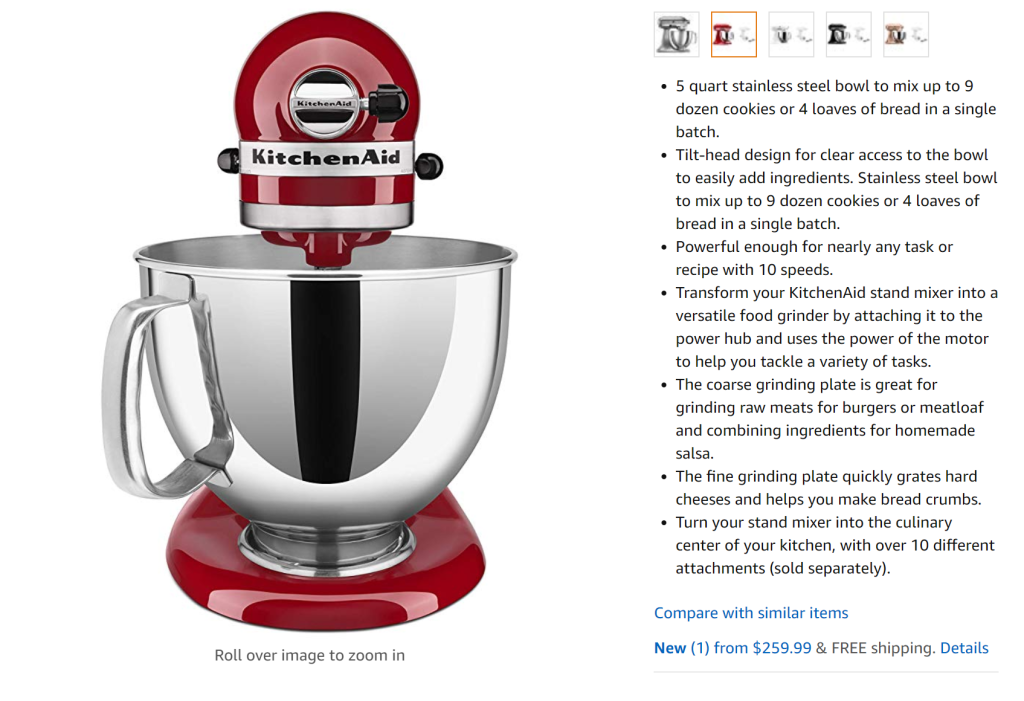
KitchenAid demonstrates its understanding of buyer challenges by highlighting key benefits in the description of its stand mixer. Several of the bullet points describe use cases that the reader will easily relate with.
2. Avoid obvious statements
An effective product description should certainly contain a description of your product – but try to avoid the obvious. If you sell shoes, for example, you probably don’t need to explain that your products are garments designed to protect the customer’s feet from the ground.
We call these “water is wet” statements. They’re obvious facts that the reader should understand intuitively. If someone reading your product descriptions doesn’t understand these essentials, they probably aren’t yet ready to buy. You can use other types of marketing content like blogs and infographics to get them up to speed before they return to your product pages.
Example: Police Dog Pet Costume
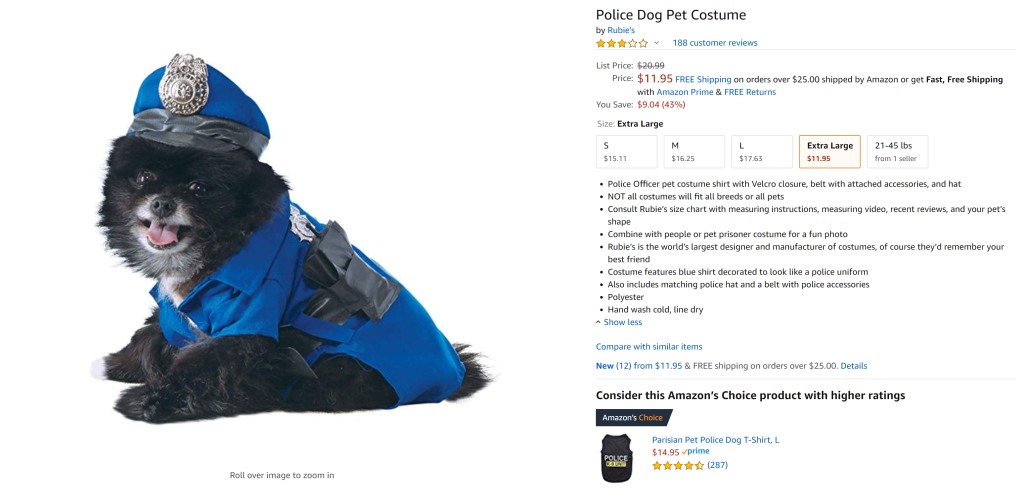
This description for a police costume for a dog describes the costume as resembling a police uniform. It’s a bit redundant, don’t you think?
3. Be careful with superlatives
If your product is the easiest, the most advanced or the best in the world, then by all means tell your customers about it. But make sure you can back up your claims. If your claims are overly bold, skeptical readers will likely roll their eyes and walk away.
You could walk from Manhattan to Brooklyn and see half a dozen or more pizza shops that claim to offer the best pies in the city. Some even claim to be world famous. Not only are these types of statements unverifiable, but they’re also easy to refute. Ask anyone in Iowa City if they’ve ever heard of Di Fara Pizzeria and you’re likely to get more blank stares than salivating mouths.
If you’re going to claim to be the best, the most intuitive, the most affordable or any other superlative, make sure you have the data to back up your claim.
Example: Titleist
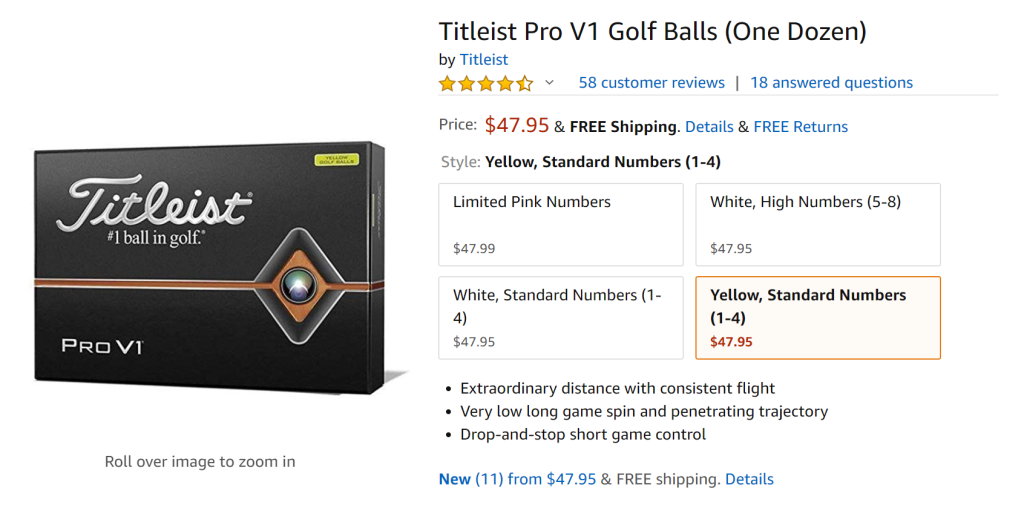
This product may be simple, but Titleist knows it’s speaking to dedicated golfers, not just casual enthusiasts. Its description uses strong, evocative language because it’s claiming to be the best on the market.
4. Appeal to your buyer’s senses
Creative writing helps buyers to imagine themselves using the product before they make a decision to buy. Evoke the five senses in your writing to spur these leaps of imagination. Expressive language elevates your product descriptions from bland characterizations to enticing depictions.
For example, clothiers selling to the fashionable crowd may describe how their outfits hang comfortably from the wearer’s frame. A maker of handcrafted fountain pens might describe how smoothly the nib distributes ink across the paper.
Spend some time using your product and make notes about the sensations you experience. How does the product make you feel? Which of your senses are involved in the experience? Work these impressions into your copy.
Example: David’s Tea
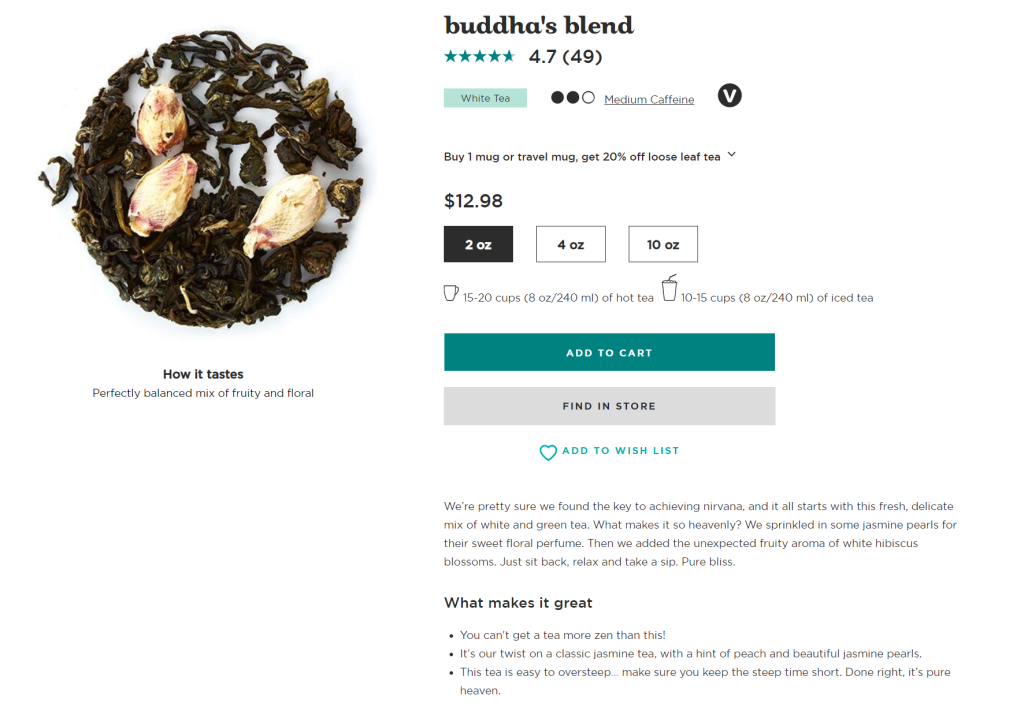
In a photo, dried tea leaves don’t look like much. David’s Tea uses product descriptions that prompt readers to imagine themselves taking a sip and inhaling the delicious aroma.
5. Tell your brand story
Every piece of marketing collateral you produce has a place within your brand story, and your product descriptions are no exception. Like any good story, the narrative of your brand should evoke an emotion in your customers.
Within your product descriptions, your brand story will likely relate to the overcoming of a challenge. As customers near the point in their journey when they’re ready to make a purchase, they’re likely anticipating how the product will make a change in their life. Your marketing copy should confirm that feeling and add to it.
Remember, you are not always the author of your brand story. Your customers are just as responsible for the direction your business takes. Find ways to include the customer in that journey and you’ll have a strong product description.
Example: Red Wing Shoes
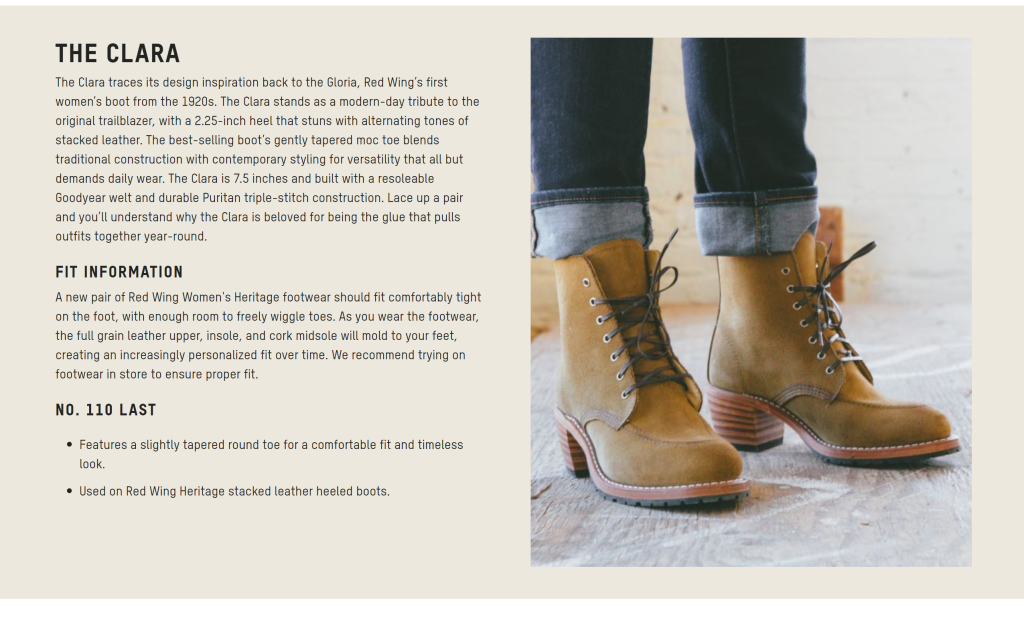
Red Wing Shoes has been around since 1905, and the brand injects all of its marketing with those decades of experience. This product description calls on the craftsmanship of a bygone era to describe this modern product.
6. Align your descriptions with other marketing efforts
Product description writers shouldn’t work in a bubble. In fact, everyone working in marketing and sales should be on the same page when describing product benefits.
Look through your recent marketing campaigns and pull out the appeals that have worked well. Your product descriptions should confirm the findings laid out in your blogs and conform with the data you present in your infographics.
Customers will likely encounter your brand several times before they decide to purchase. If they see discrepancies between your ad campaigns, they may think twice about handing over their hard-earned cash.
Example: Squarespace

Squarespace aligns its traditional advertising messages with the copy found on its product pages. In the ad example, Squarespace claims that its websites can help businesses stand out in the marketplace. In the description example, the brand extends the claim by showing how its SEO tools increase brand awareness.
7. Provide social proof
When customers see how other buyers have benefitted from a product or service, they’re more likely to make a purchase. Including social proof such as testimonials and case studies in your product descriptions can nudge customers in the right direction.
For example, you could include customer snapshots of their purchased products in addition to your polished imagery. This can help potential buyers to imagine themselves using your product. In addition, some customers will always take marketing copy with a grain of salt. Social proof helps these customers see how your offerings perform in the real world.
Example: The Bullet Journal Method by Ryder Carroll
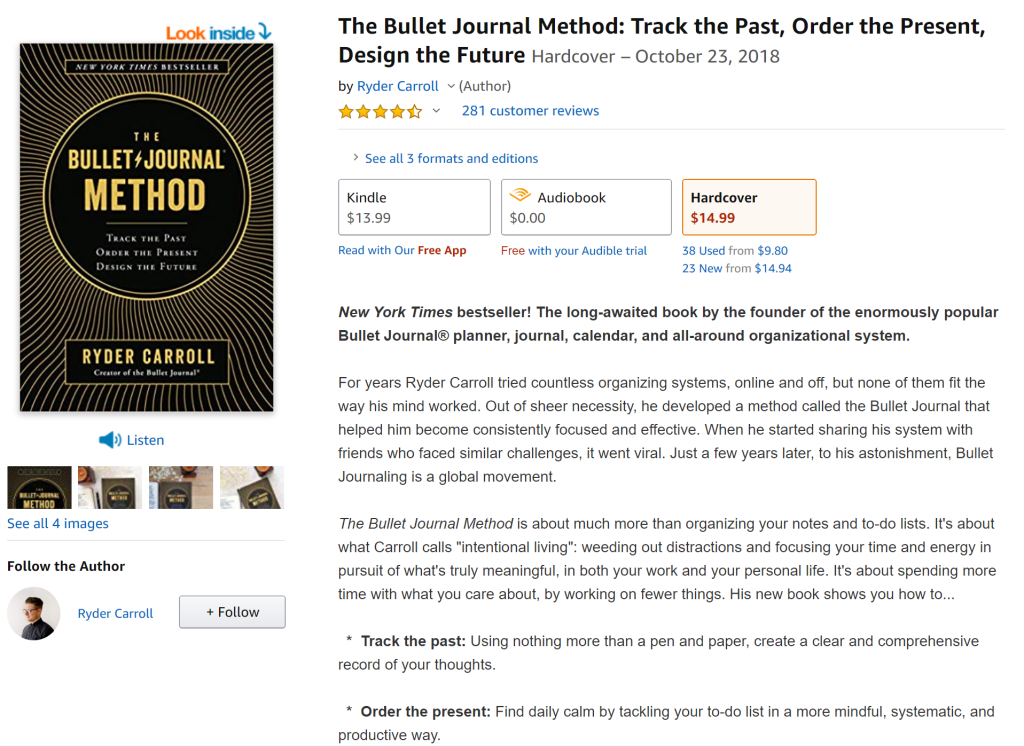
This example follows a tried-and-true method of social proof that book sellers have leveraged for decades. Above the description, in bold text are those coveted words: “New York Times bestseller.” Clearly, many people have already benefited from the advice within the book.
8. Optimize your text for readability
The length of your product description will depend on the offering and the assumed level of knowledge possessed by your target audience. Whether you need just a few sentences or a couple of paragraphs, you should ensure your descriptions are scannable.
Use bullet points, short paragraphs and bolded words to help potential buyers find the information they need immediately. If you need to go into detail about several aspects of your product, then consider writing a brief summary followed by more detailed paragraphs.
Example: GreenWorks
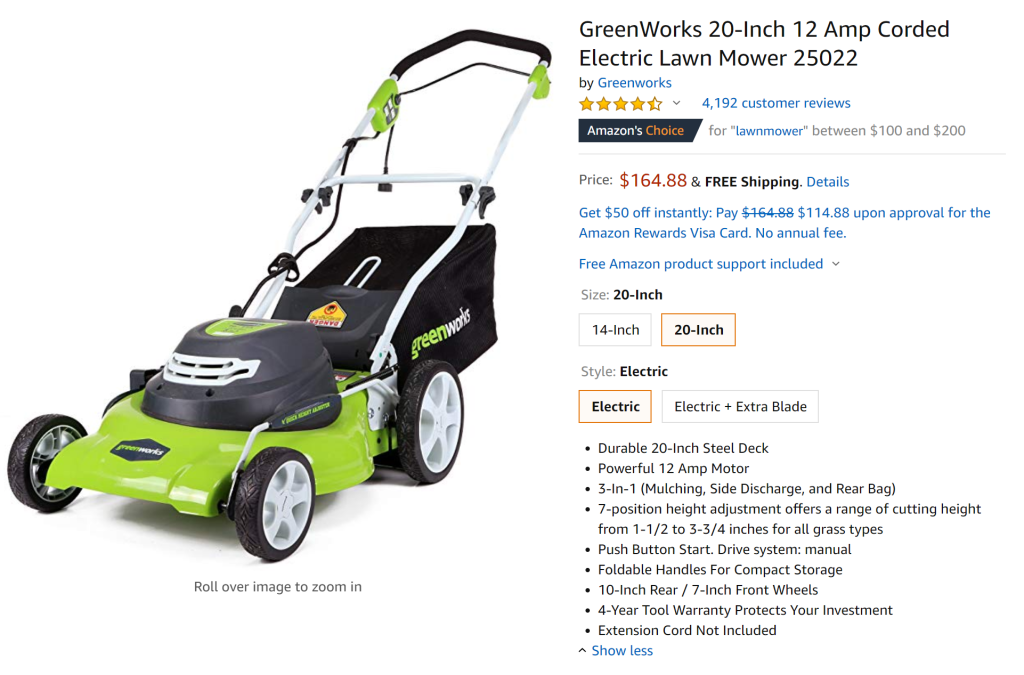
It’s just the facts in this scannable product description. Potential buyers are probably comparing several different mowers based on price point and features. This description clearly lays out the most important details to help customers make their purchase decision.
9. Don’t forget about SEO
Written product descriptions have two audiences: humans who will buy your products and search algorithms that will help humans find your product pages. Placing keywords in your product descriptions can help them to rank higher on search engine results pages (SERPs), as well as site-specific search results, such as on the Amazon marketplace.
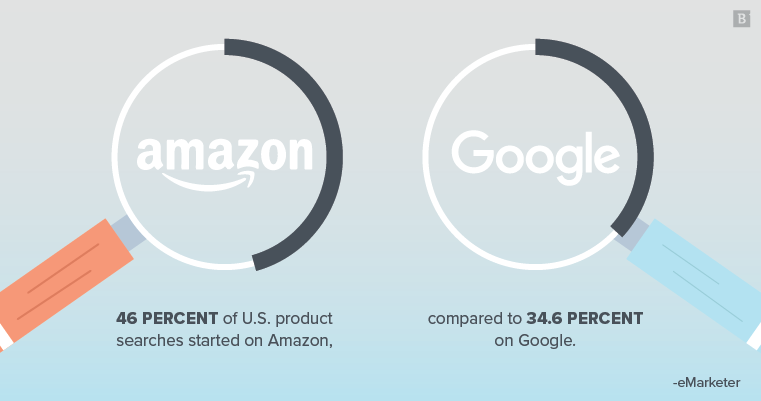
Try to include one keyword in your product titles and one or two more in your bullet points. Think about the search queries that users might use to find your product and use similar language.
Check out our complete Amazon SEO guide to learn more.
Example: Bose
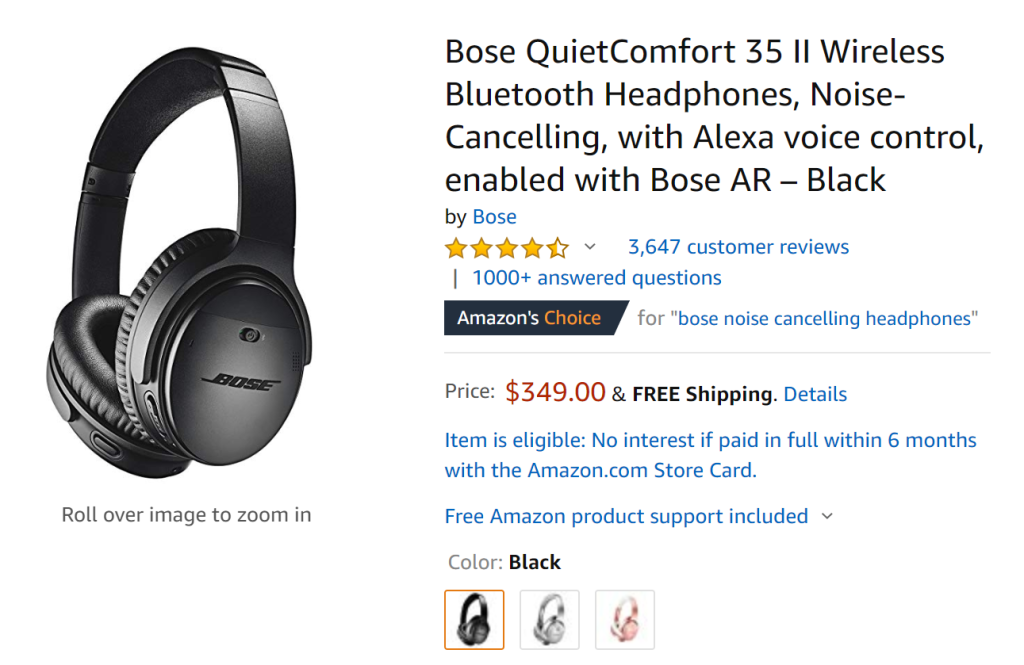
The product title for these headphones contains several keywords that potential buyers might search on Amazon. This way, a single description can capture buyers looking for Bluetooth-enabled products, noise-cancelling devices or headphones equipped with digital assistants.
10. Use a mix of media
Effective product descriptions are accompanied by enticing imagery. Use high-definition pictures and videos to support the claims made in your copy. For instance, if you can claim that your product makes a process more efficient, show this advantage in action.
For many shoppers, seeing is believing. The more concrete proof you can provide to support your claims, the better. This is also a great opportunity to repurpose some of your other marketing materials. For instance, if you have recorded a product demonstration, cut it up into short clips or gifs to display on your product page.
Example: Milk Bar
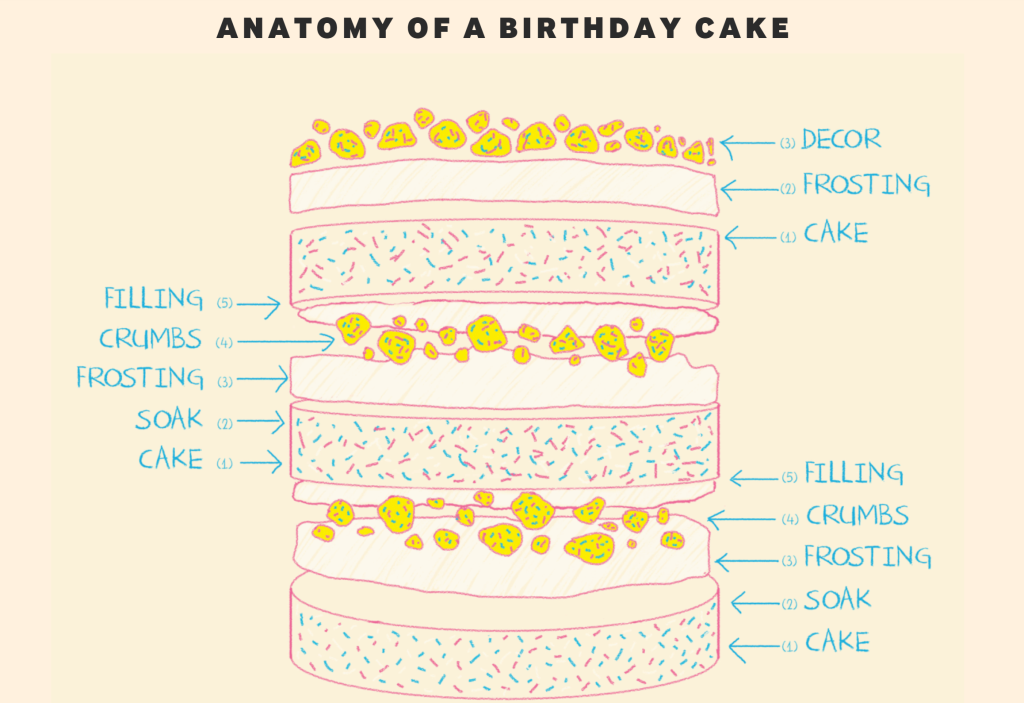
Milk Bar uses a combination of photography, high-definition gifs, illustrations and text to describe its birthday cake offering. Each piece works in tandem to appeal to the reader’s senses as well as their need for a quality product. Potential buyers have everything they need to make a decision.
11. Conduct split tests
Even the best marketing writers don’t create perfect copy the first time around. There is simply too much to know about your target audience. No matter how much prior research you conduct, you’ll likely miss something important.
So what happens when you have two or more great ideas, but you don’t know which will drive the most sales? That’s where split testing comes in. Using a tool like Google Optimize or enterprise email marketing platforms , you can test multiple versions of your copy and measure the results of each to determine which is best.
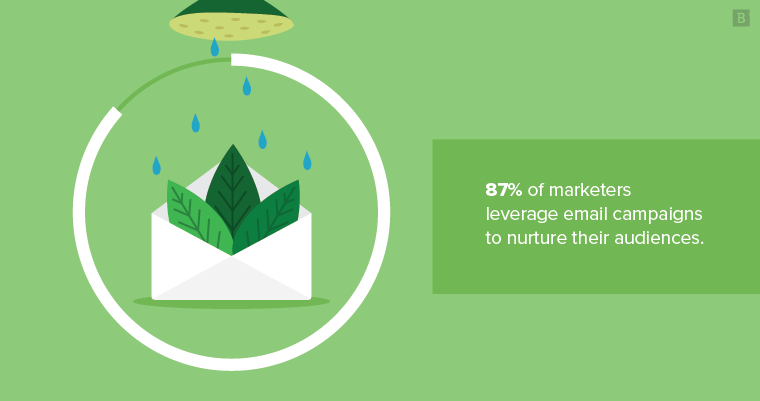
You might find that a certain turn of phrase leads to more conversions than another. But you won’t know until you test them both.
Repurposing descriptions as marketing collateral
Product descriptions should fit nicely into your content repurposing workflow . If you follow the best practices above, each of your descriptions will be a highly optimized summary of everything customers want to know about your offerings.
The next time you’re stuck for an appeal when creating new content, you can turn to your product descriptions for inspiration. In addition, the alignment between your product pages and content marketing will help steer potential buyers in the right direction.
By repurposing your product descriptions, you can extend the reach of your content and ensure that new buyers are exposed to your products’ features and benefits.
Alexander Santo
Share this article
Get our weekly newsletter

Alexander Santo is a Brafton writer living in Washington. He enjoys searching for the perfect cup of coffee, browsing used book shops and attending punk rock concerts.
Recommended Reading

Crafting B2B2C Copy That Speaks to the Right Crowd
What’s the quickest way to mess up your B2B2C marketing content? Writing to the wrong audience. In business-to-business-to-consumer (B2B2C) marketing, it’s all too easy to write copy with end customers in mind. However, your goal is to win over the business leaders who serve those people. Let’s look at the who’s-who of B2B2C marketing, how… Read more »

4 Content Writing Examples to Help You Reach Your Audience (Infographic)
Learn more about the different types of content writing with these detailed content writing examples.
The Content Marketer
Get the latest content marketing updates delivered directly to your inbox with our weekly newsletter.

- AI Content Shield
- AI KW Research
- AI Assistant
- SEO Optimizer
- AI KW Clustering
- Customer reviews
- The NLO Revolution
- Press Center
- Help Center
- Content Resources
- Facebook Group
How to Craft a Detailed Product Description in Business Plan
Table of Contents
A well-written product description in your business plan has the potential to attract investors and aid in the expansion of your company.
In addition to describing your manufactured goods, your product description should emphasize the benefits of the goods. These benefits must align with your business.
This article discusses developing a product description for a business plan and offers writing advice to help you craft your own.
What Is a Product Description in Business Plan?
The product description in the business plan describes all the products the company produces .
A business plan product description describes a product or service, the firm supplying it, the problem it answers, the price, and the target market. Your product description should explain how your products differ from similar ones on the market or why they’re needed if no market exists.
Product descriptions should be factual and not promotional or salesy. As with other business papers, a product description should be in the first person, so it doesn’t appear overly promotional.
A product description in a business plan should be understandable, so the value of your products is clear.
What Does a Product Description Entail?
A product description introduces your product to potential investors and customers. The following items below should be included in the document when presenting your product to potential investors and customers.
1. Features and Benefits of the Product
Describe the features and benefits of your product. If your product addresses a problem for customers, this section should convey that information.
2. Your Product Vs. Competition
Take a look at the competition and see how your product stacks up. Make a case for why your product is better than your competition’s offerings.
3. Price of Product
Include the price of your product and how it compares to other similar products on the market in your pitch. The cost of production, the selling price, and the profit margin all need to be discussed.
4. Trademarks
You should add this information if you’ve had your product tested by professionals in the field. Including any certifications, intellectual property, copyrights, or patents is also a good idea.
These awards and honors bolster your product’s credibility. As a result of being awarded patents and trademarks, your company is the only one that can make this product. This increases the product’s worth.
5. the Life Cycle of the Product
The idea, prototype, and expansion stages are part of a product’s life cycle. If you’re still in the concept stage, use this section to explain how you’ll build the product and why it’s necessary.
If you already have a prototype, discuss how you intend to evaluate it and manufacture your product. Include it here if you have been producing your product but need to grow to meet demand.
6. Distribution and Sales Strategy
Describe your product’s distribution strategy, including how and where it will be sold. Vendors, brick-and-mortar stores, and online retailers are examples of possible sales channels. If you already have a list of suppliers selling your goods, insert their names and addresses here.
7. Product Delivery to Final Consumer
How do you intend to get your product into the hands of your clients? All the manufacturing and shipping details should be included here. Include information on the manufacturer, such as their location and manufacturing time. It is advisable to outsource the production of your goods, including delivery schedules and methods.
8. Resources
Identify any unique equipment, materials, or technology required to produce your product.
9. Future Expansion Projections
As your firm grows, describe your product development and introduction plans.
10. Evidence in the Form of Photos and Brochures
Photos and brochures can help investors visualize your goods. Include pictures and brochures in an appendix to your business plan, but reference them in the product description.
With a business plan product description, you’ll enlighten the reader about the firm, the product, and its market .
A product description tells the reader what the product is. It also explains how it works, how it benefits the company and consumers, and how much it costs.

Abir Ghenaiet
Abir is a data analyst and researcher. Among her interests are artificial intelligence, machine learning, and natural language processing. As a humanitarian and educator, she actively supports women in tech and promotes diversity.
Explore All Product Description Generator Articles
T-shirt product description: essential tips to increase sales.
Product description is essential for the success of your t-shirt brand. A well-crafted t-shirt product description can be the difference…
- Product Description Generator
How to Create a Template for Product Description
Have you ever experienced customers asking many questions about a product you are selling through your store? Maybe because you…
Top Service Description Examples You Should Explore
The way you write your product or service descriptions has a direct effect on your sales figures. However, many small…
Want To Write SEO Friendly Product Descriptions?
A successful eCommerce business relies heavily on its product descriptions. A strong description gives you the ability to allay any…
Benefits of Effective Amazon Product Descriptions
Amazon is a powerful tool for sellers and entrepreneurs. As the competition on Amazon and the e-commerce world gets more…
Examples of Cool Product Descriptions for Clothes
The clothing business is growing, and demand has never been higher. It’s a lot of work bringing new ideas to…
- Search Search Please fill out this field.
- Building Your Business
- Becoming an Owner
- Business Plans
How to Write the Business Plan Products and Services Section
Get tips on writing the products and services part of your business plan
:max_bytes(150000):strip_icc():format(webp)/P2-ThomasCatalano-1d1189bf85d0470eb415291cb149a744.jpg)
- The Products and Services Section
- What to Include
- Tips on Writing the Section
The products and services section of your business plan is more than just a list of what your business is going to provide. This section of your business plan should include details about how you'll price products and services, how you'll fulfill orders, and other details that investors need to hear before you can get funding . Learn more below.
Key Takeaways
- Business plans include details about products and services you'll offer, including exactly how you plan to market, sell, and deliver on customer orders.
- The best business plans are clear and concise.
- The products and services section of your plan should show off why your product or service is needed.
- The products and services section should also convey the expertise and experience you have to succeed.
Why You Need a Products and Services Section in a Business Plan
The business plan products and services section is the centerpiece of your plan. While other sections of your business plan are important, the products and services section is the essence of your business and the point around which every other part of the business plan is built .
What to Include in a Products and Services Section
The products and services section of your business plan outlines your product or service, why it's needed by your market, and how it will compete with other businesses selling the same or similar products and services.
Your products and services section should include a description of the products or services you are offering or plan to offer (including future products or services). You should explain how your products and services will be priced and a comparison of the products or services your competitors offer in relation to yours.
You should also include the sales literature you plan to use. Detail your marketing materials, and clarify the role your website will play in your sales efforts.
The products and services section will include a paragraph or so on how orders from your customers will be processed or fulfilled, as well as any needs you have to create or deliver your products, such as up-to-date computer equipment. If your process depends on intellectual property or legal issues, such as trademarks , then those need to be addressed.
Tips on Writing the Products and Services Section
This section of your business plan should excite those you're hoping will fund your business or work with you. To that end, here are a few tips to create a products and services section that appeals to the reader.
Indicate Why Your Product or Service Is Needed
Especially if you're venturing into a new concept or invention, or a place where there is no current market, you need to explain the need for your product or service.
Highlight the Features of Your Product or Service
A crucial part of business success is the ability to set yourself apart from other businesses that sell the same or similar products and services. What features, such as price point or level of service, do you offer that are unique to you?
Focus on Benefits
Unique features are important, but even more vital is how those features provide value to consumers. Translate your features (i.e., faster or cheaper) into benefits (i.e., get it now or save money). The goal is to highlight how your product or service will fix a problem or improve a client or customer's life.
Be Clear and Concise
Don't let your business plan get bogged down in too much description and information. Use bullets or numbered lists to quickly and easily highlight important information.
Show Off Expertise, Experience, and Accolades
You not only want to describe your products and services but also share why you're the best person to provide them. Include anything in your education or experience that makes you an expert in this business. If you have testimonials, awards, or endorsements, share those. Finally, if you've applied for a patent, copyright, or trademark, include that as well.
Be the Expert, But Use Layman's Terms
You should know your product, service, and industry well, but don't expect your potential funders and partners to have the same level of knowledge. Assume the reader doesn't know as much as you when you explain what you're offering.
Avoid acronyms and jargon when outlining your products and services.

Indicate What's Special About Your Products or Services
Will you be offering a special guarantee or refund policy? Do you have a quicker or more unique way of delivering your product or service?
Speak to Your Customer
While you don't want to write an advertorial, you do want to be customer-oriented when you write your products and services section.
Examples of a Products and Services Section
The Small Business Administration offers business plan examples that you can draw from to help guide your writing. Here's an example of a products section for someone creating "Wooden Grain Toys."
Wooden Grain Toys will sell wooden toys made from solid hardwoods (maple, beech, birch, cherry, and oak) and steel rivets. The toys are handcrafted and designed for small children to easily use. Our line currently includes the following nine models:
- All-Purpose Pick-Up Truck w/movable doors and tailgate
- Dump Truck w/functioning dumping mechanism and box
- Biplane (two-seater) w/movable propeller
- Steam engine with coal tender - additional cars available separately: caboose, flat car w/logs, box car, tank car, coal car
- Flat-Bed Truck w/logs
Wooden Grain Toys will offer its products for the following prices:
- All-Purpose Pick-Up Truck w/movable doors and tailgate - $25
- Dump Truck w/functioning dumping mechanism and box - $30
- Biplane (two-seater) w/movable propeller - $20
- Additional train cars (single car) - $5
- Additional train cars (three cars) - $12
- City Bus - $12
- Tow Truck - $18
- Flat-Bed Truck w/logs - $35
- Sports Car - $20
- Sedan - $20
What Is Product and Service in a Business Plan?
A products and services section of a business plan clarifies exactly what your business will produce , how much it'll sell for, and other details along those lines.
What Are Examples of Products and Services?
A product or service can be anything a business creates to turn a profit. Some businesses have both products and services. For example, a restaurant's services include cooking for and serving customers. The restaurant's products are the dishes and drinks it creates.
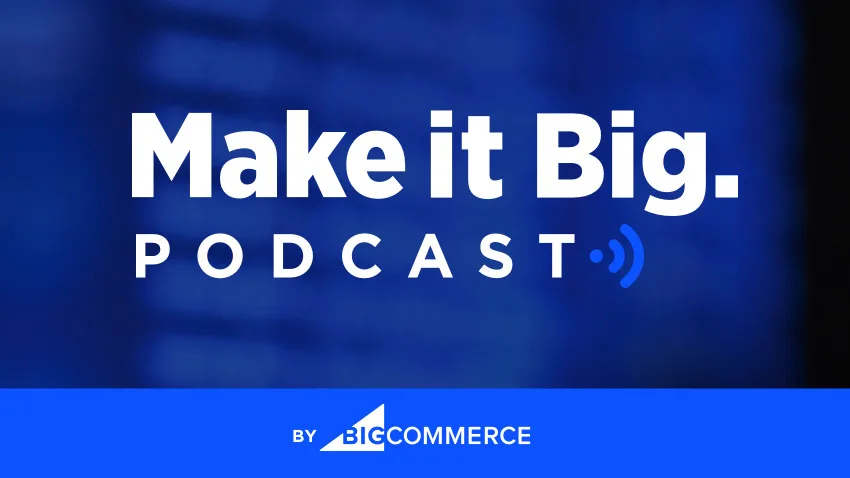
Ecommerce insights on the go
Tune in to the Make it Big Podcast — our thought leadership audio series for retailers, entrepreneurs and ecommerce professionals. You'll get expert insights, strategies and tactics to help grow your business.
How To Write Product Descriptions To Grow Online Sales

No matter the size of your online store , product descriptions play a key role in your ecommerce business.
Effective product descriptions can possibly lure potential customers . Good product descriptions can potentially influence a purchase decision. Great product descriptions can ultimately help improve conversion rates and increase sales , as well as boost your visibility and SEO on paid channels .
The technical details, including the use of power words and A/B tests, can be the difference between a potential buyer on your ecommerce website and those customers shopping at a competitor with similar products.
Business owners, marketers and copywriters all know the importance of writing product descriptions, but what’s the best way to help reach your target audience ?
What are Product Descriptions?
A product description is a form of marketing copy used to describe and explain the benefits of your product. In other words, it provides all the information and details of your product on your ecommerce site.
These product details can be one sentence, a short paragraph or bulleted. They can be serious, funny or quirky. They can be located right next to or underneath product titles and product images. They can be scannable selling points or have strong readability.
There are multiple styles and ways to make product descriptions work for your ecommerce store, but there’s much more to them than simple copywriting.
Creating the Best Product Descriptions
There’s no doubt product descriptions can help take your business to the next level, but what should they say? How long should they be? Which format is best? How do you make the products rank high for Search Engine Optimization (SEO)?
Here’s a product description template to follow:
1. Think about the who, what, when, where, why and how before writing.
This method is often used by journalists to provide facts in their stories and it is the first step in crafting a product description.
Who is this product for? The target audience can be gender (i.e. male or female), an age group (i.e. college students or retirees), a lifestyle demographic (i.e. new mothers or car enthusiasts) or some other defined group of people.
What are the product’s basic details? This includes attributes such as dimensions, materials, product features, cost and functions.
When should someone use the product? Is it meant to be used during a certain time of day, seasonally or for a specific type of occasion? Just as important is pointing out if a product can or should be used every day or year-round. These details will help speak to the product’s long-term value.
Where should someone use the product? Is it meant for indoor or outdoor use, for your car or your home?
Why is this product useful or better than the competition? This can be anything from quality to value to features. Think about the product benefits to your customers and consider how images can complement your product copy.
How does the product work? This may not be necessary for every product, but it’s a must-have feature if you are selling anything with moving parts or electronics.
Let’s now dive into ways to make your product pages and landing pages shine.
2. Determine the best format to describe your products.
When starting to craft your perfect product description, it’s important to determine the best format to use.
Since some online shoppers only scan text on websites, it might be helpful to use bullet points that cover the most important product details. Bullet points should generally be used for specs (like dimensions) or short phrases (like features) so they are quick and easy to read.
Unfortunately, bullet points aren’t always the best way to tell a product’s story and convince target customers that they are looking at a great deal. They can look cold and clinical on a page instead of engaging the shopper’s emotions or imagination.
To avoid those common mistakes and pain points, use prose instead.
By writing a paragraph (three or more sentences) or two about the product, retailers can set the scene and help the shopper realize why their life up to this point has been incomplete without it. It may seem daunting, but after some practice, it will become second nature and even (gasp!) fun.
This is your opportunity to be a little creative and establish a voice (personality and tone) for your brand. Just imagine you’re at a party, telling someone you’ve just met about the product. How would you describe it so that they would understand how great it truly is?
This brand voice permeates every aspect of your online marketing: social media, SEO, paid search — every customer touchpoint. Unique, compelling copy makes your products more relevant for search engines and other marketing mediums that value original content.
In fact, following this simple formula below is a great way to writing compelling product descriptions:
[Paragraph(s) of Prose] + [Bulleted List of Specs or Product Features] = [Engaging Product Description]
3. Choose goals and KPIs to measure success of your product descriptions.
You need goals to measure the success of product descriptions.
“But this is going to take a long time,” you might be thinking, especially if you rely on product descriptions from your distributors or manufacturers. And you’re right, this isn’t a quick process. However, if you can commit to writing product descriptions using the formula above, you can begin to see a variety of benefits:
An increase in conversion rate.
A decrease in cart abandonment.
A lower return rate.
Fewer calls from shoppers.
Improved organic search rankings.
There are countless product description examples, including on platforms such as Amazon, BigCommerce and Shopify.
4. Make your product descriptions short and sweet.
Don’t overthink it. Use conversational paragraph-long descriptions to engage fans and ideal customers as well as quick bullet points with need-to-know specs to concisely convey the most important information for online shoppers.
5. Use storytelling to your advantage.
Does your product have a backstory that’s particularly special to you? Chances are it will be particularly special and endearing to your audience, too. Use that story in your product description to add more character to your item, engage your audience and win hearts and minds.
6. Don’t be afraid to boast.
Here’s how you take the product description formula above one step further. Is your product differentiated through a founder’s expertise? Is your product better because of years of testing? Is it hand-crafted? Does it get strong social proof with testimonials and product reviews?
Call that out!
Tell a better story in your short product description paragraph by including tidbits of detail that prove why your product is better than the rest. Don’t be afraid to name drop, either.
7. Get technical to win trust when needed.
If you have a more technical product, don’t be afraid to get in the weeds with your product description. Prove to your customer your brand’s expertise in the industry by providing all possible details they’d need to know before they ever even have to ask.
8. Know when to show and not tell.
Text isn’t always the best way to describe your product. If you are getting too wordy, think about how you can simplify.
Images carry weight and are better remembered by customers. If possible, show off your product in a visual that explains exactly what the product does.
9. Know when to show, tell and describe.
Other than graphics, videos can be an effective way to showcase how to use a product or why it is better than others. Many brands use videos , graphics and text to drive the point home.
10. Don’t be afraid to be unique.
While a short paragraph description on a product page is a best practice, know when that isn’t what your audience wants. Every industry and online business is unique. Do you know your customer well enough to know they won’t read that product description? Are all of your customers scanners?
Pull out the content that is most important to them and find engaging, visual ways to get all the relevant information to them without any headache. Your buyer personas should inform the overall form and approach toward your product descriptions, including the website design and white space on the page.
Go Big or Go Home
In all, it’s important to first know your audience in order to determine what kind of content will best speak to them to increase conversions.
The ecommerce product description formula works for most brands, but it’s only a starting point.
Think visually. Add graphics and optimize your product images. A/B test copy and get personal on those pages. Look at Google Search Console to identify popular terms and power words so you can improve SEO traffic to the product page.
Whether you’re selling t-shirts or strollers, shoppers like to buy from people they trust and building trust is different based on what you are selling.
From the moment you use a website builder and construct your site’s design, think about how images and descriptions can work in harmony to tell your story to customers. There are countless examples of product descriptions, but find the best fit for your business.
Know your audience. Know your product. And then, show and tell with your online shop descriptions.

How to Write the Products and Services Section of Your Plan

1 min. read
Updated January 3, 2024
A complete business plan describes what you sell: either products, services, or both. This section needs to be more than a simple list of what you provide. It should detail the problem you’re solving, the value you provide, how it compares to the competition, and logistical information like pricing and distribution.
Learn how to go beyond simple product or service descriptions and create a compelling narrative around what you intend to offer.
What to include in the products and services section
What you add to this section fully depends on how much information you need to include in order to fully describe your products and services. While you may end up not including everything, it will benefit your business to work through these common topics.
A description of the problem and your solution
Successful businesses solve a problem for their customers. They make their lives easier or fill an unmet need and you need to identify and effectively describe a pain point that you are solving.
Optional information to strengthen your product and services section
While not required, there are additional pieces of information about your product and service offerings that you may want to include. These can be especially valuable for convincing investors that you have a business worth investing in.
Demonstrate business traction
Traction is an early indication that customers are eager to buy what you’re selling. Early sales, pre-orders, sign-ups, or contracts are just a few ways you can prove your idea has merit.
Understand the importance of intellectual property
Do you have patents, copyrights, or trademarks? It may be valuable to mention them here. They can be further proof that your idea has merit and the legal standing to be successful.
Why is the products and services section important?
The products and services section of your business plan provides the chance to describe why you’re in business. This will range from specific product or service details, such as pricing information, to more personally driven elements like your mission statement.
The point is that you need to paint a convincing picture, both technical and sentimental, of what you offer, how it works, and why it’s valuable. It needs to be a section that stands on its own and that is fully supported by the other sections of your plan.
See why 1.2 million entrepreneurs have written their business plans with LivePlan
Tim Berry is the founder and chairman of Palo Alto Software , a co-founder of Borland International, and a recognized expert in business planning. He has an MBA from Stanford and degrees with honors from the University of Oregon and the University of Notre Dame. Today, Tim dedicates most of his time to blogging, teaching and evangelizing for business planning.

Table of Contents
- What to include
- Optional information
- Why is this section important?
Related Articles

10 Min. Read
How to Write a Competitive Analysis for Your Business Plan

3 Min. Read
What to Include in Your Business Plan Appendix

24 Min. Read
The 10 AI Prompts You Need to Write a Business Plan

How to Set and Use Milestones in Your Business Plan
The Bplans Newsletter
The Bplans Weekly
Subscribe now for weekly advice and free downloadable resources to help start and grow your business.
We care about your privacy. See our privacy policy .

The quickest way to turn a business idea into a business plan
Fill-in-the-blanks and automatic financials make it easy.
No thanks, I prefer writing 40-page documents.

Discover the world’s #1 plan building software
Product Description
- Written By Gregg Rosenzweig
- Updated: November 8, 2023
What is a product description? A product description is a piece of writing that conveys the features and benefits of a product, ranging from basic facts to stories that make a product compelling to an ideal buyer.
When you’re considering buying something online, what’s one of the first things you do? Scroll to the product description to find out more details, right?
That’s why this intro to your product or service is such a crucial component of marketing — it’s a chance to solidify the sale, increase customer confidence in your business, and reduce customer service emails by providing the answers to common questions upfront.
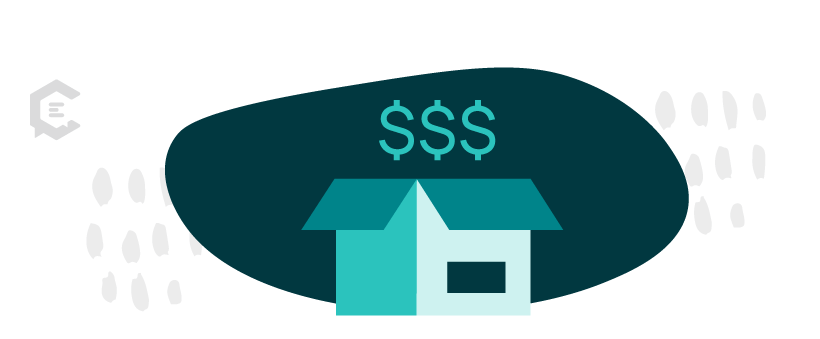
What is a product description?
A product description is a piece of writing that conveys the features and benefits of a product, ranging from basic facts to stories that make a product compelling to an ideal buyer.
Product descriptions commonly include…
- Physical product details and features
- Technical specifications
- Product uses and benefits
- Types of materials used in construction
- Stories relating the product to the ideal buyer
- How something’s produced (i.e., manufactured or handmade)
- Where something’s made (or the sourcing in the production chain)
- Sustainability details
- Pricing details
- Delivery details
How long should a product description be?
Depending on the cost, complexity, or purchase frequency of a product, the length can vary. For example, purchasing a car requires far more information than buying a pair of jeans.
- Short form (50 words or less)
- Standard (100 words)
- Long form (250+ words)
What can product descriptions do for a business?
Aside from educating and enticing potential customers, the best descriptions can help you differentiate your product and brand from your competitors by putting forward your most salient features and benefits.
As mentioned many times: ads only get you so far. If you want to ultimately convert customers with content , you have to give them the information they need to make a decision.
Benefits of product descriptions
Any business, regardless of industry, can use descriptions to sell their goods, whether they are intended for B2B, B2C, or D2C (direct to consumer) markets.
Here’s a look at the benefits:
- Increases SEO for your product pages
- Helps consumers compare features and benefits
- Builds trust in your products and brand
- Improves conversion by moving customers further down the purchase funnel
Product description examples – short form
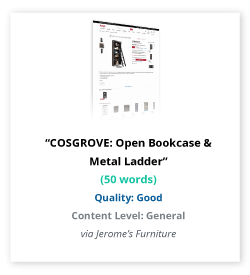
Product description examples – standard form
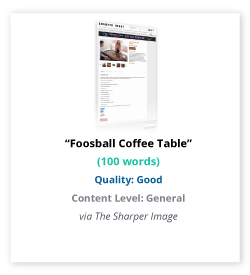
Product description examples – long form
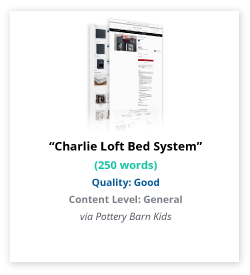
Our team rated the examples above according to three degrees of quality ( Good, Better, Best ) to help you understand what makes a great product description and to better gauge the resources needed for your content plan.
In general, the degrees of content quality correspond to our three content levels ( General, Qualified, Expert ) based on the criteria below so you understand how much time it’ll take to create similar content and/or who you’d need to hire.
Please consider there are multiple variables that could determine the cost, completion time, or content level for any content piece with a perceived degree of quality.

Want some help creating persuasive product descriptions? Talk to a content specialist at ClearVoice and find out how we can craft expert product descriptions that boost your SEO, increase trust, and get sales.
Stay in the know.
We will keep you up-to-date with all the content marketing news and resources. You will be a content expert in no time. Sign up for our free newsletter.
Elevate Your Content Game
Transform your marketing with a consistent stream of high-quality content for your brand.

You May Also Like...

The Strategic Ensemble Behind Effective Content

Everything to Know About the Power of SEO Personalization

Personalized Content Strategies: Gaining the Competitive Edge
- Content Production
- Build Your SEO
- Amplify Your Content
- For Agencies
Why ClearVoice
- Talent Network
- How It Works
- Freelance For Us
- Statement on AI
- Talk to a Specialist
Get Insights In Your Inbox
- Privacy Policy
- Terms of Service
- Intellectual Property Claims
- Data Collection Preferences
- Entrepreneurship

How to Write a Product Description for a Business Plan?
As a business owner, you know that a well-written business plan is essential to the success of your venture. Your business plan should include a product description that is clear, concise, and compelling. A good product description will help potential investors and customers understand what your product is, how it works, and why it is valuable. In this article, we will guide you through the process of writing a product description for your business plan.
1. Define your target audience
The first step in writing a product description is to define your target audience. Who is your product for? What problem does it solve for them? What benefits will they get from using it? The more specific you can be about your target audience, the better you can tailor your product description to their needs.
When defining your target audience, consider factors such as age, gender, income, education level, and lifestyle. Research your target audience to understand their pain points, desires, and motivations.
2. Describe the problem your product solves
In this section, you need to clearly describe the problem your product solves. Explain the pain points of your target audience and how your product addresses those pain points. Use concrete examples and data to illustrate the problem.
For instance, if you are selling a productivity app, you might describe the problem of having too many tasks to complete in a day and not enough time to complete them. You could then explain how your app helps users prioritize their tasks, set reminders, and track their progress.
3. Explain how your product works
Once you have described the problem your product solves, it’s time to explain how your product works. Be specific and use simple language that your target audience will understand. You should also include any technical details that are relevant to your product.
Consider creating a table to illustrate the features and benefits of your product. This will make it easy for potential investors and customers to understand what your product does and how it works.
4. Highlight the benefits of your product
In this section, you need to highlight the benefits of your product. What makes it unique? What advantages does it have over competitors? How will it improve the lives of your target audience?
Use specific examples and data to illustrate the benefits of your product. Consider creating a list of benefits in HTML format to make it easy for readers to scan.
5. Describe your pricing strategy
Your product description should include a pricing strategy. Explain how you will price your product and what factors you have considered. Will you offer discounts or promotions? What is your profit margin?
Consider creating a table to illustrate your pricing strategy. This will make it easy for potential investors and customers to understand your pricing model.
6. Outline your marketing strategy
Your product description should also include a marketing strategy. Explain how you plan to promote your product and reach your target audience. What channels will you use? How will you measure the success of your marketing efforts?
Consider creating a list of marketing channels in HTML format to make it easy for readers to scan.
7. Include a competitive analysis
Your product description should include a competitive analysis. Research your competitors and explain how your product is different. What advantages does your product have over competitors? What are the weaknesses of your competitors?
Consider creating a table to compare your product to your competitors. This will make it easy for potential investors and customers to understand how your product stacks up.
8. Discuss your team and resources
Your product description should also include information about your team and resources. Explain who will be responsible for developing and marketing your product. What skills and experience do they have? What resources do you have available?
Consider creating a table to illustrate your team and resources. This will make it easy for potential investors and customers to understand your capabilities.
9. Include a timeline
Your product description should include a timeline. Explain when you plan to launch your product and what milestones you need to achieve along the way. What are the risks and challenges you need to overcome?
Consider creating a timeline in HTML format to make it easy for readers to understand your plan.
10. Summarize your product description
Finally, you should summarize your product description. Use a concise statement to describe your product and its benefits. This will make it easy for potential investors and customers to remember what your product is all about.
Consider using bullet points to summarize your product description in HTML format. This will make it easy for readers to scan and remember your key points.
In conclusion, writing a product description for your business plan is an important step in launching a successful venture. By following the steps outlined in this article, you can create a product description that is clear, concise, and compelling. Remember to tailor your product description to your target audience and use concrete examples and data to illustrate your points.
Frequently Asked Questions
Here are some common questions and answers about writing a product description for a business plan.
What is the purpose of a product description in a business plan?
A product description in a business plan is a brief overview of the product or service that your business offers. The purpose of this section is to provide potential investors or lenders with a clear understanding of what your product is, how it works, and what makes it unique. A well-written product description can help convince investors that your business is worth investing in.
When writing a product description, it’s important to be as specific and detailed as possible. Include information about the product’s features, benefits, and how it solves a problem for your target audience. Use language that is clear and easy to understand, and avoid technical jargon or industry-specific terms that may confuse investors who are not familiar with your field.
What should be included in a product description?
A product description should include a brief overview of the product, its key features and benefits, and how it solves a problem for your target audience. You should also include information about the product’s target market and any relevant industry trends or market data that supports your business case.
When writing a product description, be sure to use language that is clear and concise. Avoid using technical jargon or industry-specific terms that may be confusing to investors who are not familiar with your field. Use bullet points to break up long paragraphs and make the description more readable.
How long should a product description be?
A product description should be concise and to the point. Ideally, it should be no longer than one or two paragraphs. However, if there are multiple features or benefits that you want to highlight, it may be necessary to use bullet points or subheadings to break up the content and make it more readable.
Remember, investors are busy people and don’t have time to read lengthy product descriptions. Keep your description short and sweet, but make sure it includes all the key information that investors need to know.
What are some tips for writing a compelling product description?
When writing a product description, it’s important to focus on the benefits of the product rather than just its features. Highlight how the product solves a problem for your target audience and why it’s better than competing products on the market.
Use language that is clear and concise, and avoid technical jargon or industry-specific terms that may be confusing to investors who are not familiar with your field. Finally, be sure to proofread your product description carefully to ensure that there are no typos or grammatical errors.
Where should the product description be placed in a business plan?
The product description should be placed early in the business plan, after the executive summary and company overview sections. This allows investors to quickly understand what your business does and how it adds value to the market.
It’s also a good idea to include the product description in any marketing materials or pitch decks that you create for your business. This will help you communicate the value of your product to potential investors and customers in a clear and concise way.
How to Write Company Description for your Business Plan?
Remember to focus on the problem your product solves, highlight its key features and benefits, and use clear and concise language that resonates with your target audience. Additionally, make sure to showcase any relevant data, such as market analysis or customer feedback, that supports the viability and potential success of your product.
With a well-crafted product description, you can not only attract investors and customers but also gain a deeper understanding of your own product and its place in the market. So take the time to research, write, and refine your description, and watch as your business plan takes shape and your product rises to the top of its industry.
RELATED ARTICLES
What is sampling in marketing research, how much does it cost to do market research, how important is marketing for small business, how to announce a partnership, how much room for budgeting in s business, how can partnership be dissolved, do non deductible expenses reduce partnership basis, 10 benefits of investing in money market instruments for businesses, 10 common business goals and how to set them, 10 common financial risks faced by businesses and how to manage them, 10 common types of bonds for business financing and investments, 10 customer retention techniques to foster long-term loyalty, how can trust be gained between the business and development, software startup ideas, the dummies guide to starting your own business, how to find new businesses before they open, what must an entrepreneur assume when starting a business, editor’s choice, how to price products small business, investor relations website vs financial reports: which is better for you, how to register a business idea, can a urse case manager be employed by the company, how to manage the performance of employees, stay in touch.
To be updated with all the latest news, offers and special announcements.
Copyright © 2023. All rights reserved.
- Privacy Policy
- Terms of Use
Advisory boards aren’t only for executives. Join the LogRocket Content Advisory Board today →

- Product Management
- Solve User-Reported Issues
- Find Issues Faster
- Optimize Conversion and Adoption
What is a product plan and how to create one in 6 steps

Whenever I read about the next hot, new start-up with unicorn potential, I can’t help but think of Pinky and the Brain .

Both titular characters in the mid-90s animated TV series are genetically modified laboratory mice. Brain is hyper-intelligent; Pinky, not so much.
Brain’s primary objective? World domination:
Pinky : Gee, Brain. What are we going to do tonight? Brain : The same thing we do every night, Pinky. Try to take over the world.
In each episode, Brain devises a diabolical yet half-baked plan — for example, manipulating the world’s biggest magnet to form discarded satellites to spell “Brain is your ruler” — that invariably ends up foiled.
What does this have to do with product management?
Devise a product plan to take over the world
If you want to make an impact with your product and solve all your customers’ problems, don’t be like Brain; take the time to devise a product plan before you make your first move on your quest for market domination.
Creating roadmaps and backlogs is a great start, but product planning covers a much wider scope.
In this guide, we’ll define what product planning means, why it’s important, and the components and steps involved in creating a product plan.
What is a product plan?
Product planning covers all the steps, activities, and decisions a company must perform and make to develop a successful product.
A product can be defined as an input-outcome device. The input is the customer value proposition and the outcome is the company’s profit. Product planning includes everything you need to do internally to get from input to outcome.
It starts with a recognized customer need — after all, customers don’t just buy a product, they buy what the product will do for them to solve a problem they are having. It ends when the product has reached the end of its usefulness from a business perspective.
What is the purpose of product planning?
Product planning encompasses the actions and components that contribute to achieving a specific outcome. Product management is all about realizing outcomes.
Before jumping into the how and what, let’s first understand why product planning is important by outlining its six objectives:
- Company survival
- Meet customer needs
- Increase sales
- Understand and manage strengths and weaknesses
- Better manage capacity
- Plan effectively
1. Company survival
The eye of the tiger, survival of the fittest — or as P. Diddy said, it’s all about the Benjamins .
Product planning allows you to focus, remain viable, and understand your ability to innovate. It also helps you clarify how to introduce, grow, and sunset products in highly competitive markets.
2. Meet customer needs
The customer is at the heart of any product. Thorough product planning will set you up to understand and meet your customers’ needs. This, in turn, helps you quickly move customers from evaluators to champions through the product-led growth flywheel .
3. Increase sales
Your product can be lightyears ahead with brilliant solutions to customer problems, yet if they are not interested in the solution and don’t buy the product, your product fails.
For example, virtual reality seems to have finally found product-market fit . VR technology though, is not new.
In the 90s, VR was on the rise and forecasted sales potential was off the charts. Unfortunately, VR systems such as the Virtual Boy failed to deliver; its poor ergonomics and underwhelming stereoscopic effect gave users terrible headaches.
With better product planning, Nintendo might’ve been able to craft a more sophisticated product that satisfied customer expectations and, as a result, increased sales.

Over 200k developers and product managers use LogRocket to create better digital experiences
4. Understand and manage strengths and weaknesses
Product planning allows you to look introspectively and analyze your strengths and weaknesses in light of market requirements. What does your product do really well? What qualities distinguish it from competitors? What does your product lack and what do competitors do better?
By asking and answering questions like these, you’ll gain a better understanding of what you can take advantage of and what you need to improve in your product.
5. Better manage capacity
What’s one thing every company has in common? Limited resources in terms of capital, material, and human resources. Product planning enables you to plan these optimally and get the most out of them.
6. Plan effectively
When you’re building products, you have many competing priorities . Will you invest in new features, enhance and improve existing ones, reduce technical debt , or spend more time on improving discovery and delivery processes ? Product planning allows you to meet your long-term strategic plans.
6 considerations for product planning
Now that we understand why product planning is essential, how do you go about doing it?
Creating a successful product plan involves the following considerations:
- Research before development
- Choose a delivery method
- Coordinate activities
- Set a price
- Commercialize the product
- Abandon unprofitable products
1. Research before development
Energy to get going: Check. Confidence it will work out: Check.
Validation that the idea will deliver what customers need? [Buzzer sounds].
Before jumping into the deep end of product development, start with extendive market and user research. The insights gathered therein will help you establish what characteristics and requirements your product must fulfil to meet customers’ needs.
2. Choose a delivery method
All roads lead to Rome. The question is, which is the most efficient?
This is even more applicable when it comes to product delivery. Which delivery method will enable you to develop your product or feature exact how the customer needs it to be?
3. Coordinate activities
Product planning aims to coordinate all the initiatives and activities around the product and its investments. Doing so allows you to improve your competitive position and strive for market leadership. It also helps you quickly respond to changing market conditions.
4. Set a price
Product planning helps you determine the ideal price point for your product.
More great articles from LogRocket:
- How to implement issue management to improve your product
- 8 ways to reduce cycle time and build a better product
- What is a PERT chart and how to make one
- Discover how to use behavioral analytics to create a great product experience
- Explore six tried and true product management frameworks you should know
- Advisory boards aren’t just for executives. Join LogRocket’s Content Advisory Board. You’ll help inform the type of content we create and get access to exclusive meetups, social accreditation, and swag.
The insights gathered during product planning can help you determine the best pricing strategy. For example, is your product most suitable for value-based, competitive, price skimming, cust-plus, penetration, economy, or dynamic pricing?
5. Commercialize the product
Product planning helps you uncover and validate the viability, feasibility, and desirability of your product.
Desirability speaks to satisfaction of customer needs and the commercialization of the product. This measure helps you ensure viability and, hopefully, rake in profits.
Product planning also considers how to best introduce the product to the market and continuously measure success post-launch .
6. Abandon unprofitable products
All good things eventually come to an end. Every decision in a product is a business decision, and there will come a time that further investment in a product or product feature becomes unprofitable.
At that point, a decision has to be made whether or not to sunset the product or feature.
Good product planning throughout the product lifecycle helps you recognize when it is time to abandon the product and sunset it in a structured way with minimal impact on customers.
How to create a product plan in 6 steps
OK, enough small talk. It’s time to deep-dive into the product planning process.
Product planning involves six steps:
- Market and user research
- Concept ideation
- Screening and testing
- Introduction and launch
- Product lifecycle
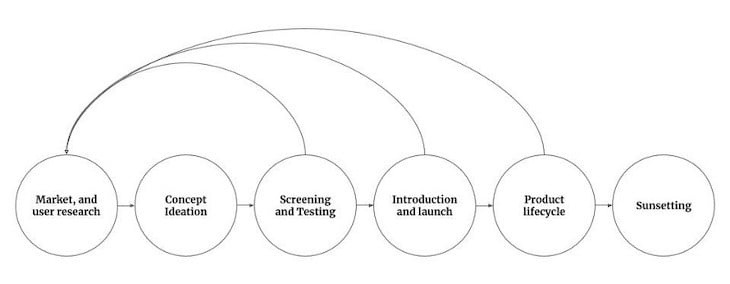
1. Market and user research
Before you start to build, it’s crucial to understand the problem you’re trying to solve, the market drivers, competitors, and customer needs. You can generate insights on all of the above through market research.
Competitive analysis , a subset of market research, is a structured approach to identifying and analyzing competitors.
Both are conducted to identify markets, investigate market positioning , and analyze the business’s success.
Through customer segmentation research, which is especially important to new businesses, larger customer groups are divided into different groups with personas.
The personas form the basis of user research, which is aimed at understanding potential customers’ problems, habits, interests, motivations, and more.
2. Concept ideation
A great product starts with a great concept and initial validation of that concept. This step is arguably the most fun and creative step.
During the concept development stage, you define what you are trying to build by figuring out how well it solves the identified problem, how easy it is to use, what it will cost the customer, the look and feel of the application, and so on.
A key step in this process step is product discovery and a continuation of user research, which enables you to uncover the problems the persona faces and the solution to aim for.
Concept ideation sources can be both external and internal. Externally, market and user research influence concept ideation. Internally, concept ideas originate from sales, customer support, marketing, engineering, designers, user research, executives, and investors.
3. Screening and testing
During screening and testing, the ideas generated during the concept ideation phase are critically evaluated.
The goal is to groom out ideas that are either inconsistent with the product vision , undesirable, and/or impractical.
After evaluation, the next step is to rigorously prioritize ideas . As the Highlander said, “ There can only be one .” This is not to say you should only test one idea; it just means you should pursue the most promising tests first.
There are plenty of prioritization frameworks to choose from with some of the most commonly used include:
- Value vs. effort
- MoSCoW method
- Opportunity scoring
Once you have a prioritized list, you should devise a hypothesis and experiment to verify or disprove it.
In product testing, customers are given an opportunity to try a prototype. This helps you understand whether customers understand the product idea, what they like or dislike about it, and whether they would ultimately buy and use it.
The concept ideation, screening, and testing as a whole are often covered in the Double Diamond approach, which is a design process to help you discover, define, develop and deliver solutions.
4. Introduction and launch
After a few iterations of screening and testing, the new features and usability improvements deemed ready to pursue and develop trickle through and are ready for development and launch.
In this step, the idea is converted into a product. It’s the PM’s job to schedule activities to ensure a successful product launch with a high adoption rate .
When ready, the product is launched and commercialized. If your product planning is sound, it should be poised to compete with existing products and maximize market share and profits.
5. Product lifecycle
After the product is launched, the real fun begins. Now it’s time to measure and analyze usage to gather new insights about whether or not your product launch was successful.
Using these insights, you can modify and enhance the product, introduce new features, improve usability, and help the product move from introduction to growth.
At a certain point, you’ll reach product maturity. The number of customers and sales will stabilize. Eventually, new investments in the product will have a harder time generating additional revenue. It will become increasingly challenging to compete.
Eventually, the product will decline, and the number of customers and sales along with it. This might be due to existing competition or the introduction of new products that are more advanced and better serve the customer’s needs.
Think about how the Walkman was surpassed by the Discman, which was overtaken by the mp3 player, and, eventually, an app on your phone.
6. Sunsetting
When a product is in decline, it’s time to sunset it. Sunsetting is also known as the end of life and usually involves deprecating the product.
Though it might feel difficult to say goodbye to a product that you birthed, nurtured, and watched grow, sunsetting a product is a perfectly natural part of the product lifecycle.
During the sunsetting phase, it is important to be diligent. You should devise a playbook or checklist to ensure all activities, such as communication, code clean-ups, and so on are covered during the end-of-life period.
Featured image source: IconScout
LogRocket generates product insights that lead to meaningful action
Get your teams on the same page — try LogRocket today.
Share this:
- Click to share on Twitter (Opens in new window)
- Click to share on Reddit (Opens in new window)
- Click to share on LinkedIn (Opens in new window)
- Click to share on Facebook (Opens in new window)
- #product strategy

Stop guessing about your digital experience with LogRocket
Recent posts:.

DSDM: The dynamic systems development method
The dynamic system development method (DSDM) was first released in 1994 as a software development method to provide some discipline to RAD.

Leader Spotlight: Enabling a vision-led product mindset, with David Krell
David Krell, VP of Product at Going, talks about the fallacy that PMs have to be in a position of authority to do vision-led work.

Examples of successful product-led growth
Think of product-led growth as a self-sufficient user experience that leads to business growth by providing value to your users.

Leader Spotlight: Developing horizon-spotting skills, with Jennifer Musser Metz
Jennifer Musser Metz, VP Product Management — Core Platforms & Expansion at Paramount+, talks about the importance of horizon spotting.
Leave a Reply Cancel reply

Call for Free Consultation (858) 876 4597
[email protected], what is in a business plan: product description (part 4 of 11).
- thestartupgarage
- September 27, 2010
- No Comments
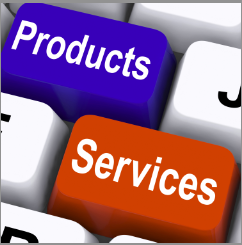
Time For Completion: Approximately 5-25 hours
In this section you get the chance to clearly explain the products or services your business will offer.
The information provided in this section will become the basis of your marketing plan.
Product description should be written so the reader can easily understand what the product is and what it does. You should never assume that your product will sell itself, so you must always include a detailed description of the product. In addition to a comprehensive explanation of your product, the Product Description should also compare your product to other similar products on the market. This gives you the opportunity to clearly define what advantages your product has over the competition
Whats in it?
A Product Description contains an overview of your product or service, the product or services features, benefits, and advantages, as well as any product development activities, and liability issues. The overview should paint a complete picture of the product by answering the following questions in detail: what the product or service is, what it does, and how it performs its function.
If possible, it is a great idea to add pictures, blueprints, or any other graphical descriptions of your product to give as clear of an explanation of your product as possible. By doing this in comparison with other competing products, you can make it clear why your product is better than the competition.
The product summary should also take time to focus on the problem(s) that your product will solve. In addition to an explanation of the problems, you should also discuss what the causes are, how the product solves these problems, and the benefits to potential customers.
A complete description of your product, the problems it solves, and a comparison with competitors should all work to make a case as to why your product will be successful.
Why it’s Important
This section of the business plan is your opportunity to completely hash out your product idea, down to the finest detail, which gives you a complete understanding of your product. The information you learn from this section will help you improve your product and differentiate from competitors.
By writing a cohesive Product Description that explains the details of the product, the need for it, and how it has advantages of its competitors, you are making a strong case for why your product will succeed and be profitable. Without this information, investors have no way of knowing if you completely understand your product, or how you plan to compete with others, which makes for a very risky investment.
The next section will discuss how to properly research your potential customers in the Market Analysis section. Remember, you can take a look at one of our sample business plans at any time.
Whether you have a question about your Product Description or you’d like to discuss our business plan writing services , feel free to contact us for a free consultation !
Leave a reply cancel reply.
Your email address will not be published. Required fields are marked *
Save my name, email, and website in this browser for the next time I comment.

- Search Search Please fill out this field.
What Is a Business Plan?
Understanding business plans, how to write a business plan, common elements of a business plan, how often should a business plan be updated, the bottom line, business plan: what it is, what's included, and how to write one.
Adam Hayes, Ph.D., CFA, is a financial writer with 15+ years Wall Street experience as a derivatives trader. Besides his extensive derivative trading expertise, Adam is an expert in economics and behavioral finance. Adam received his master's in economics from The New School for Social Research and his Ph.D. from the University of Wisconsin-Madison in sociology. He is a CFA charterholder as well as holding FINRA Series 7, 55 & 63 licenses. He currently researches and teaches economic sociology and the social studies of finance at the Hebrew University in Jerusalem.
:max_bytes(150000):strip_icc():format(webp)/adam_hayes-5bfc262a46e0fb005118b414.jpg)
A business plan is a document that details a company's goals and how it intends to achieve them. Business plans can be of benefit to both startups and well-established companies. For startups, a business plan can be essential for winning over potential lenders and investors. Established businesses can find one useful for staying on track and not losing sight of their goals. This article explains what an effective business plan needs to include and how to write one.
Key Takeaways
- A business plan is a document describing a company's business activities and how it plans to achieve its goals.
- Startup companies use business plans to get off the ground and attract outside investors.
- For established companies, a business plan can help keep the executive team focused on and working toward the company's short- and long-term objectives.
- There is no single format that a business plan must follow, but there are certain key elements that most companies will want to include.
Investopedia / Ryan Oakley
Any new business should have a business plan in place prior to beginning operations. In fact, banks and venture capital firms often want to see a business plan before they'll consider making a loan or providing capital to new businesses.
Even if a business isn't looking to raise additional money, a business plan can help it focus on its goals. A 2017 Harvard Business Review article reported that, "Entrepreneurs who write formal plans are 16% more likely to achieve viability than the otherwise identical nonplanning entrepreneurs."
Ideally, a business plan should be reviewed and updated periodically to reflect any goals that have been achieved or that may have changed. An established business that has decided to move in a new direction might create an entirely new business plan for itself.
There are numerous benefits to creating (and sticking to) a well-conceived business plan. These include being able to think through ideas before investing too much money in them and highlighting any potential obstacles to success. A company might also share its business plan with trusted outsiders to get their objective feedback. In addition, a business plan can help keep a company's executive team on the same page about strategic action items and priorities.
Business plans, even among competitors in the same industry, are rarely identical. However, they often have some of the same basic elements, as we describe below.
While it's a good idea to provide as much detail as necessary, it's also important that a business plan be concise enough to hold a reader's attention to the end.
While there are any number of templates that you can use to write a business plan, it's best to try to avoid producing a generic-looking one. Let your plan reflect the unique personality of your business.
Many business plans use some combination of the sections below, with varying levels of detail, depending on the company.
The length of a business plan can vary greatly from business to business. Regardless, it's best to fit the basic information into a 15- to 25-page document. Other crucial elements that take up a lot of space—such as applications for patents—can be referenced in the main document and attached as appendices.
These are some of the most common elements in many business plans:
- Executive summary: This section introduces the company and includes its mission statement along with relevant information about the company's leadership, employees, operations, and locations.
- Products and services: Here, the company should describe the products and services it offers or plans to introduce. That might include details on pricing, product lifespan, and unique benefits to the consumer. Other factors that could go into this section include production and manufacturing processes, any relevant patents the company may have, as well as proprietary technology . Information about research and development (R&D) can also be included here.
- Market analysis: A company needs to have a good handle on the current state of its industry and the existing competition. This section should explain where the company fits in, what types of customers it plans to target, and how easy or difficult it may be to take market share from incumbents.
- Marketing strategy: This section can describe how the company plans to attract and keep customers, including any anticipated advertising and marketing campaigns. It should also describe the distribution channel or channels it will use to get its products or services to consumers.
- Financial plans and projections: Established businesses can include financial statements, balance sheets, and other relevant financial information. New businesses can provide financial targets and estimates for the first few years. Your plan might also include any funding requests you're making.
The best business plans aren't generic ones created from easily accessed templates. A company should aim to entice readers with a plan that demonstrates its uniqueness and potential for success.
2 Types of Business Plans
Business plans can take many forms, but they are sometimes divided into two basic categories: traditional and lean startup. According to the U.S. Small Business Administration (SBA) , the traditional business plan is the more common of the two.
- Traditional business plans : These plans tend to be much longer than lean startup plans and contain considerably more detail. As a result they require more work on the part of the business, but they can also be more persuasive (and reassuring) to potential investors.
- Lean startup business plans : These use an abbreviated structure that highlights key elements. These business plans are short—as short as one page—and provide only the most basic detail. If a company wants to use this kind of plan, it should be prepared to provide more detail if an investor or a lender requests it.
Why Do Business Plans Fail?
A business plan is not a surefire recipe for success. The plan may have been unrealistic in its assumptions and projections to begin with. Markets and the overall economy might change in ways that couldn't have been foreseen. A competitor might introduce a revolutionary new product or service. All of this calls for building some flexibility into your plan, so you can pivot to a new course if needed.
How frequently a business plan needs to be revised will depend on the nature of the business. A well-established business might want to review its plan once a year and make changes if necessary. A new or fast-growing business in a fiercely competitive market might want to revise it more often, such as quarterly.
What Does a Lean Startup Business Plan Include?
The lean startup business plan is an option when a company prefers to give a quick explanation of its business. For example, a brand-new company may feel that it doesn't have a lot of information to provide yet.
Sections can include: a value proposition ; the company's major activities and advantages; resources such as staff, intellectual property, and capital; a list of partnerships; customer segments; and revenue sources.
A business plan can be useful to companies of all kinds. But as a company grows and the world around it changes, so too should its business plan. So don't think of your business plan as carved in granite but as a living document designed to evolve with your business.
Harvard Business Review. " Research: Writing a Business Plan Makes Your Startup More Likely to Succeed ."
U.S. Small Business Administration. " Write Your Business Plan ."
- How to Start a Business: A Comprehensive Guide and Essential Steps 1 of 25
- How to Do Market Research, Types, and Example 2 of 25
- Marketing Strategy: What It Is, How It Works, and How to Create One 3 of 25
- Marketing in Business: Strategies and Types Explained 4 of 25
- What Is a Marketing Plan? Types and How to Write One 5 of 25
- Business Development: Definition, Strategies, Steps & Skills 6 of 25
- Business Plan: What It Is, What's Included, and How to Write One 7 of 25
- Small Business Development Center (SBDC): Meaning, Types, Impact 8 of 25
- How to Write a Business Plan for a Loan 9 of 25
- Business Startup Costs: It’s in the Details 10 of 25
- Startup Capital Definition, Types, and Risks 11 of 25
- Bootstrapping Definition, Strategies, and Pros/Cons 12 of 25
- Crowdfunding: What It Is, How It Works, and Popular Websites 13 of 25
- Starting a Business with No Money: How to Begin 14 of 25
- A Comprehensive Guide to Establishing Business Credit 15 of 25
- Equity Financing: What It Is, How It Works, Pros and Cons 16 of 25
- Best Startup Business Loans for May 2024 17 of 25
- Sole Proprietorship: What It Is, Pros and Cons, and Differences From an LLC 18 of 25
- Partnership: Definition, How It Works, Taxation, and Types 19 of 25
- What Is an LLC? Limited Liability Company Structure and Benefits Defined 20 of 25
- Corporation: What It Is and How To Form One 21 of 25
- Starting a Small Business: Your Complete How-to Guide 22 of 25
- Starting an Online Business: A Step-by-Step Guide 23 of 25
- How to Start Your Own Bookkeeping Business: Essential Tips 24 of 25
- How to Start a Successful Dropshipping Business: A Comprehensive Guide 25 of 25
:max_bytes(150000):strip_icc():format(webp)/GettyImages-1456193345-2cc8ef3d583f42d8a80c8e631c0b0556.jpg)
- Terms of Service
- Editorial Policy
- Privacy Policy
- Your Privacy Choices

COMMENTS
Ensure that your product description is easy to understand. Present your product in easy-to-understand terms to give potential partners without industry expertise the ability to see the value in your business plan. Show off a little. Remember that you selling a product and selling yourself as the best provider of that product.
1. Portfolio: The range of products and/or services that a business offers to potential and current customers. 2. Features and benefits (value proposition): Explain what the product/service does and how it works. 3. Problem and solution (value proposition cont.): The problem (s) the product or service solves.
Nonetheless, the product and services description section of your business plan is expected to include: The Product or Service Description; It is important the product description section of your business plan clearly explains the concept of your product, coupled with all aspects of purchasing, manufacturing, packaging, and distribution.
When writing your own product descriptions, think about how your product engages the senses. Whether it's the "crisp" sound of a new keyboard, the "smooth" feel of a luxury fabric, or the "bright" flavor of a fresh fruit, sensory language can make your product descriptions more engaging. 8. Add social proof.
1. Start with SEO. Identify a descriptive SEO keyword or keywords that you want your product to rank for on SERPs. You can read up on SEO best practices and use a tool like Moz or Ahrefs to identify target keywords, or outsource SEO to a marketing agency. In general, your target keyword should appear in several places on each product page ...
Step 3: Establish Your Listing's Tone. The tone of a product description is the "personality" of your store or brand as conveyed through your writing. Having a consistent and clear tone is a large part of successful branding, and incorporating brand tone into your product descriptions can have a big impact.
Its description uses strong, evocative language because it's claiming to be the best on the market. 4. Appeal to your buyer's senses. Creative writing helps buyers to imagine themselves using the product before they make a decision to buy. Evoke the five senses in your writing to spur these leaps of imagination.
Most business plans also include financial forecasts for the future. These set sales goals, budget for expenses, and predict profits and cash flow. A good business plan is much more than just a document that you write once and forget about. It's also a guide that helps you outline and achieve your goals. After completing your plan, you can ...
The product description in the business plan describes all the products the company produces. A business plan product description describes a product or service, the firm supplying it, the problem it answers, the price, and the target market. Your product description should explain how your products differ from similar ones on the market or why ...
How to Write the Business Plan Products and Services Section. Get tips on writing the products and services part of your business plan. By Randy Duermyer. Updated on October 14, 2022. Reviewed by. Thomas J. Catalano. Fact checked by David Rubin. In This Article. The Products and Services Section.
Apr 6, 2015. Shutterstock. This article is part of a series on how to write a great business plan. In the Products and Services section of your business plan, you will clearly describe--yep--the ...
In fact, following this simple formula below is a great way to writing compelling product descriptions: [Paragraph (s) of Prose] + [Bulleted List of Specs or Product Features] = [Engaging Product Description] 3. Choose goals and KPIs to measure success of your product descriptions. You need goals to measure the success of product descriptions.
In a business plan, the Products and Services section is typically included within the business overview section. This allows you to first introduce the business model and what it offers to customers. Only after this you can provide more details of the products and services. The Products and Services section should clearly detail what you are ...
The products and services section of your business plan provides the chance to describe why you're in business. This will range from specific product or service details, such as pricing information, to more personally driven elements like your mission statement. The point is that you need to paint a convincing picture, both technical and ...
Benefits of product descriptions. Any business, regardless of industry, can use descriptions to sell their goods, whether they are intended for B2B, B2C, or D2C (direct to consumer) markets. Here's a look at the benefits: Increases SEO for your product pages. Helps consumers compare features and benefits. Builds trust in your products and brand.
A product description in a business plan is a brief overview of the product or service that your business offers. The purpose of this section is to provide potential investors or lenders with a clear understanding of what your product is, how it works, and what makes it unique. A well-written product description can help convince investors that ...
Common items to include are credit histories, resumes, product pictures, letters of reference, licenses, permits, patents, legal documents, and other contracts. Example traditional business plans. Before you write your business plan, read the following example business plans written by fictional business owners.
Product management is all about realizing outcomes. Before jumping into the how and what, let's first understand why product planning is important by outlining its six objectives: Company survival. Meet customer needs. Increase sales. Understand and manage strengths and weaknesses. Better manage capacity.
Here's how to write one that works for your business. 1. Start with your basics. The goal of a business description is to introduce any reader to your company—-and to do that quickly. So when you're getting started writing this description, it's a good idea to list out the basic information that you'll need to include.
This section of the business plan is your opportunity to completely hash out your product idea, down to the finest detail, which gives you a complete understanding of your product. The information you learn from this section will help you improve your product and differentiate from competitors. By writing a cohesive Product Description that ...
Business Plan: A business plan is a written document that describes in detail how a business, usually a new one, is going to achieve its goals. A business plan lays out a written plan from a ...
HACCP - Steps 2 and 3: product description and intended use. Complete product descriptions are a fundamental requirement for developing a HACCP plan. Product information will include all relevant safety information including the product's composition, processing, packaging, shelf life and storage requirements. Once the nature and ...
A good marketing plan lays out the marketing actions you need to execute. For each action item, it should spell out the potential revenue, expenses and timing required to be successful in meeting your financial goals. This webinar will cover the following: Setting financial and strategic marketing goals. Defining your product or service using the "Four Ps".